- Skip to main content
- Skip to header right navigation
- Skip to site footer

Systrix IT Solutions
Leading Travel IT Solutions Company in Middle East
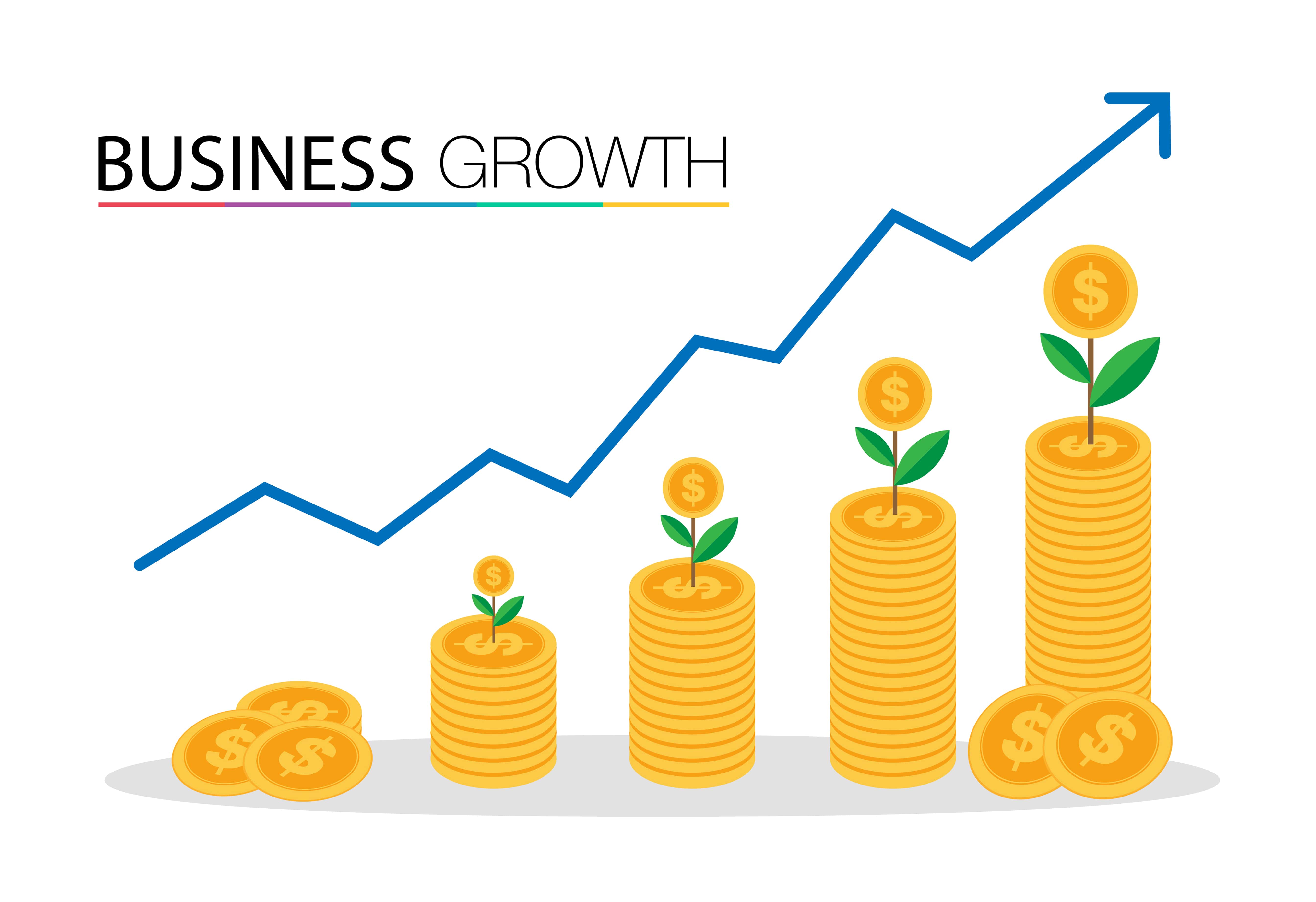

Travel agency Software: A Guide to complete Mark-up Strategies
How superior mark-ups can drive your travel agency.
The travel industry thrives on calculated decisions. Every travel agency software juggles maximizing revenue while offering competitive prices. This is where mastering mark-up strategies becomes your game-changer.

Demystifying Mark-ups and Their Benefits for travel agencies
A mark-up is the additional percentage you add to your base cost (often the supplier’s rate) to generate profit. Think of it as your value proposition – the additional revenue you earn for the expertise and services you provide. Here’s how strategic mark-ups empower your travel agency:
- Profit Management: Mark-ups allow you to establish a baseline price (rack rate) and then add your desired profit margin. This empowers you to control your revenue stream and ensure financial sustainability.
- Competitive Pricing: By strategically adjusting markups, you can offer competitive prices that attract customers in a dynamic market without sacrificing profitability.
- Dynamic Inventory Management: Mark-ups have become a powerful tool for managing inventory. You can incentivize sales for specific destinations or travel dates by implementing temporary mark-down strategies. This can entice customers to less popular destinations or off-peak seasons, ultimately optimizing your inventory utilization.
Implementing Powerful Mark-up Strategies with Systrix Travel Software
Systrix, a leading travel software company, empowers you to leverage mark-ups for optimal business growth. Our comprehensive travel management solution offers robust features to streamline mark-up management and unlock new profit potential. Here are some key strategies to consider, all seamlessly supported by Systrix:
- Tailored Mark-ups for Diverse Products and Services: Not all travel components require the same markup. Systrix allows you to create multiple, customizable mark-up profiles for flights, hotels, activities, car rentals, cruises, and other services. This ensures you maximize profit based on demand, product type, and market dynamics.
- Example: Dynamic Pricing for Peak Seasons and Events
- Imagine a prime music festival in Rio de Janeiro. Hotels will experience a surge in demand. With Systrix’s travel software, you can create a temporary markup profile offering slightly adjusted rates to capitalize on peak seasonality and ensure hotels reach maximum occupancy. This flexibility allows you to cater to customer demand while maintaining profitability.
- Looking For a Demo Version. .

Agent-Specific Mark-ups: Reward Your Top Performers!
Systrix empowers you to create agent-specific markup profiles, fostering a performance culture and rewarding your top performers. High-volume agents can receive lower mark-ups, increasing their commission and motivating further sales. This win-win situation incentivizes agents and drives overall business growth.
: Example: Rewarding High Performers with Lower Mark-ups
Agent A consistently exceeds sales targets. You can create a mark-up profile with a lower commission for Agent A within Systrix. This allows them to offer better competitive prices, close more deals, and earn higher overall commissions through increased sales volume.
Branch and Franchise Mark-ups: Cater to Diverse Sales Channels
Do you have a network of branches or franchised locations? Systrix empowers you to set mark-ups for specific branches or agent categories. This allows you to incentivize performance based on regional variations, cater to the needs of different sales channels, and maintain brand consistency across your network.

Unlocking Profit Potential with Systrix Travel Software for travel agency
Systrix equips you with a powerful suite of features to revolutionize your mark-up strategy and unlock new profit potential:
- Create Multiple Mark-up Profiles: Designate profiles for different agents, product categories, customer segments, or business goals with complete ease.
- Apply Multi-level Mark-ups: Set mark-ups at supplier, country/city, branch, or even product category level for maximum flexibility and control over your pricing strategy.
- Manage Flight Rules with Precision: Define mark-ups, discounts, and management fees for flight ticketing activities, including cancellations, issuances, and re-issuances, Voids.
- Real-time Reporting and Analytics: Gain valuable insights into your markup performance through comprehensive reports and data visualization tools. Track trends, identify areas for optimization, and make data-driven decisions to further refine your mark-up strategy.
- Multi-currency Support: Tailored Mark-ups for a Global Audience
Systrix understands that markup strategies can vary depending on the target market. Our multi-currency portal empowers you to create customized markup profiles for different currencies. This allows you to factor in regional economic considerations and optimize pricing for each geographic segment.
Benefits for Travel Agency and Travelers
Strategic mark-up strategies create a win-win situation for both travel agencies and travelers:
- Increase profitability and achieve sustained financial growth.
- Offer competitive pricing while maintaining healthy margins.
- Invest in technology and resources that enhance the customer experience.
- Reward top-performing agents and incentivize sales growth.
Systrix Travel Accounting Software: Designed for Efficiency, Built for Success
Contact Systrix. , today and discover how our innovative travel accounting software can transform your travel agency by providing multiple markup strategies and features. Focus on what matters most – creating unforgettable travel experiences – while Systrix empowers you to manage your finances with exceptional efficiency and profitability and propel your business toward sustainable growth.

A Look at How Travel Agents Make Money
The average travel agent earns between $47,000 and $55,000 annually.
Most travel agents’ income is made up of their salary, but they also earn from commissions, service fees, and markups.
Generally, the more experienced and niche a travel agent is, the higher the commission and other fees they charge.
They are also multiple types of travel agents, with some specializing in leisure travel, others in business travel, and some offer niche travel services, like adventure or eco-tourism.
Table of Contents
- 1.1 1. Leisure Travel Agents
- 1.2 2. Business Travel Agents
- 1.3 3. Niche Travel Agents
- 2 How Much Commission Travel Agents Make on Flights
- 3.1 1. Markups
- 3.2 2. Service fees
- 3.3 3. Package deals
- 3.4 4. Incentives
- 4.1 1. Commissions
- 4.2 2. Service Fees
- 4.3 3. Salaries
- 5 Travel Agent Commission Rates
- 6 Travel Agents Make Good Money
- 7 Travel Agents Don’t Expect Tips
- 8 Who Even Uses Travel Agents Anymore?
3 Different Types of Travel Agents
These are the three main types of travel agents.
1. Leisure Travel Agents
Leisure travel agents specialize in vacation and leisure planning for both individuals and families.
They can book flight tickets and hotels and arrange tours and activities for travelers.
2. Business Travel Agents
Business travel agents specialize in business travel for businesses and their employees.
Their services include booking flight tickets, hotel rooms and coordinating ground transportation.
3. Niche Travel Agents
Niche travel agents specialize in niche types of traveling, like adventure travel or eco-tourism.
Each niche travel agent specializes in a specific niche, and use their niche travel knowledge to plan customized trips for niche travelers.
How Much Commission Travel Agents Make on Flights
Travel agents commonly receive commissions for selling travel products and services.
For flights, a travel agent can make 5% commission on domestic flights, and 10-20% for international flights.
For instance, a travel agent could sell an international roundtrip flight for $1,000. And if their commission rate is 15%, they’ll receive $150 for the sale.
When it comes to cruises, travel agents can expect to make approximately 10-15% of the pre-tax price on a cruise.
4 Ways Travel Agents Make Money
Besides commission, travel agents make their money through the following four ways.
Travel agents sometimes add a markup to their travel products and services to earn extra income.
For instance, a travel agent could add a $10 markup to a hotel room that costs $90.
They’ll charge the traveler $100 total for the hotel room, with the $10 being their fee for finding and booking the room.
The exact markup an agent charges depends on the products they’re selling and their arrangement with their supplier.
The most experienced travel agents naturally have the highest markup.
2. Service fees
Travel agents also sometimes charge a flat or percentage service fee.
For example, they could charge you a flat $200 for arranging your trip, or they could charge 5% for the total cost of your trip.
The service fees are charged for providing you with their services, including booking your flights and hotels, arranging for tours and transport, and filing your visa applications.
The exact fee depends on the agent’s experience and reputation.
The most experienced and well-reputed travel agents charge the highest fees.
Inexperienced agents may not charge any service fees at all.
3. Package deals
Travel agents often create and sell packages, which contain a group of products or services given at a discounted price.
These packages can be customized to specific travelers or designed to decrease costs for them.
There are four main types of package deals.
- Flight and hotel ticket packages: This package will have discounted flight and hotel tickets.
- All-inclusive packages: This will include everything from flight and hotel tickets to meals and activities – all at a discounted price.
- Tour packages: This package will include guided tours and activities in addition to flight and hotel tickets.
- Cruise packages: This package includes a cruise vacation along with pre-cruise and post-cruise flight and hotel tickets.
The agents earn from packages by adding markups, service fees, and commissions to their packages.
4. Incentives
Travel companies often provide incentives and bonuses to agents for selling a specific number of services.
The incentives range from cash rewards to complimentary trips and other benefits.
Travel agents often earn additional income from these incentives.
How Travel Agents Get Paid
Travel agents are paid via the following three ways.
1. Commissions
The travel agent receives a percentage of the sales they make for a product or service.
2. Service Fees
Travel agents sometimes charge the traveler an upfront flat or percentage service fee directly.
3. Salaries
Travel agents earn a base salary of $39,770 according to Salary.com
Travel Agent Commission Rates
Most host agencies provide between a 7% and 8% commission.
These are the usual commission tiers for annual sales:
- $0 to $49,999: 10%
- $50,000 to $249,999: 13%
- $250,000 to $499,999: 14%
- $500,000 and higher: 15%
These are the normal commission tiers in terms of passengers:
- 0 to 20 passengers: 10%
- 21 to 49 passengers: 11%
- 50 to 199 passengers: 13%
- 200 and more: 15%
Travel Agents Make Good Money
Most travel agents earn between $47,000 and $55,000 annually, including their salary and other payments.
The exact income of a travel agent depends on their skills, experience, and relationship with suppliers.
Experienced travel agents with a high number of sales and a good relationship with suppliers can earn substantially more than $55,000 per year, though.
All travel agents receive their salary every month. But the rest of their payments depend on the specific business arrangement with their clients and suppliers.
Most agents receive commissions after a customer finishes their travels. Most also receive their service fees upfront.
Travel Agents Don’t Expect Tips
Travel agents sometimes receive tips from wealthy customers.
But it’s not particularly common for them to receive tips, nor do most travel agents depend on or expect tips as part of their job.
Who Even Uses Travel Agents Anymore?
Many people still use travel agents today because they provide a personalized service, such as luxury travelers looking for a luxurious vacation that exactly matches their tastes and needs.
Travelers with complex trips that involve multiple destinations may hire travel agents to better manage their trips.
In conclusion:
- Most travel agents earn between $47,000 and $55,000 annually.
- This figure includes a salary of around $45,000, with the rest of their income coming from commissions, service fees, and markups on goods and services.
- The exact income for a travel agent depends on their skills, experience, and relationship with their suppliers.
- An experienced travel agent with a large number of annual sales, a good relationship with their suppliers, and high commission rates can earn more than $55,000.
Ella Dunham
Ella Dunham, a Freelance Travel Journalist and Marketing Manager, boasts an impressive career spanning eight years in the travel and tourism sectors.
Honored as one of "30 Under 30" by TTG Media (the world’s very first weekly travel trade newspaper), a "Tour Operator Travel Guru" and "Legend Award" winner, Ella is also a Fellow of the Institute of Travel, a Member of the Association of Women Travel Executives, has completed over 250 travel modules, and hosts travel-focused segments on national radio shows where she provides insights on travel regulations and destinations.
Ella has visited over 40 countries (with 10 more planned this year).
Related Posts:
Understanding margin and markups
Learn about adding markup, what's available, and how to determine your margin.
In business - and especially in travel - markup is a common method for making money. But how do margin and markup differ, what options are available, and how can you manage it with Duffel?
Markup is generally known as the amount a business adds to the cost of a product to make up the final selling price so they can make money.
Margin is generally known as the profit generated after accounting for costs.
Markup is shown as a percentage of costs while margin is shown as a percentage of revenue . These two terms usually get confused as they both have similar inputs: what the product sold for and the cost of the product.
Let's take an example to help clarify:
A flight sells for £100 and it costs the airline £70 - so the difference is £30.
- Markup would be calculated as £30/£70 = 42.9%
- Margin would be calculated as £30/£100 = 30%
Can I charge my customers a markup?
Yes, you can add a markup. You can choose to add a markup to flights and/or ancillaries such as seat selection and additional baggage.
It's a common pricing strategy to add a markup to cover your operating costs and make a profit.
You can learn more ways to make money selling flights by reading our blog post: How NDC helps travel sellers make money in 2022 .
How much can I mark up?
Adding a markup is completely in your control.
If you're using Duffel Payments , you can choose any amount as long as it covers the offer and services total amount, foreign exchange rate (if applicable), and Duffel Payments fee.
If you're using Duffel Balance, you have greater flexibility on the markup, as long as your balance has enough funds to cover the cost of the flight.
If the entire cost of the flight is greater than £5,000 you'll get a validation error. Read the Payment Intents documentation to learn more. To have this limit increased, please reach out to us.
You have the flexibility to choose markup based on your own pricing strategy. For example, you could add 3% on flights from Europe if that's your most popular region or 5% on ancillaries from easyJet if most of your passengers add extras to easyJet flights. You still pass the field amount to us that includes your own markup and covers the cost of the flight.
How do I add markup?
Can my customer see the markup? How do I add markup so the customer only sees one price?
If you're integrating Duffel into your own app or website, you have control over exactly what the customer sees, so you can choose to show them whatever price you want. That could be the price that Duffel is charging you, more, or less.
Remember, some customers are more price sensitive than others and will go directly to the airline's website or use a price comparison tool when researching flights. Also note, if the customer books their flight with you but goes to the airline website to confirm their flight details with their booking reference number, they will see the price excluding markup.
When you build your integration, you also need to build tools to control what markups are applied and when for example setting rules to determine when markup is applied or forecasting prices based on different scenarios to optimise your markup. We don't offer tools for this today.
Adding markup in the test order environment
Check out our Collecting Customer Card Payments guide that walks through collecting customer payments including adding a markup:
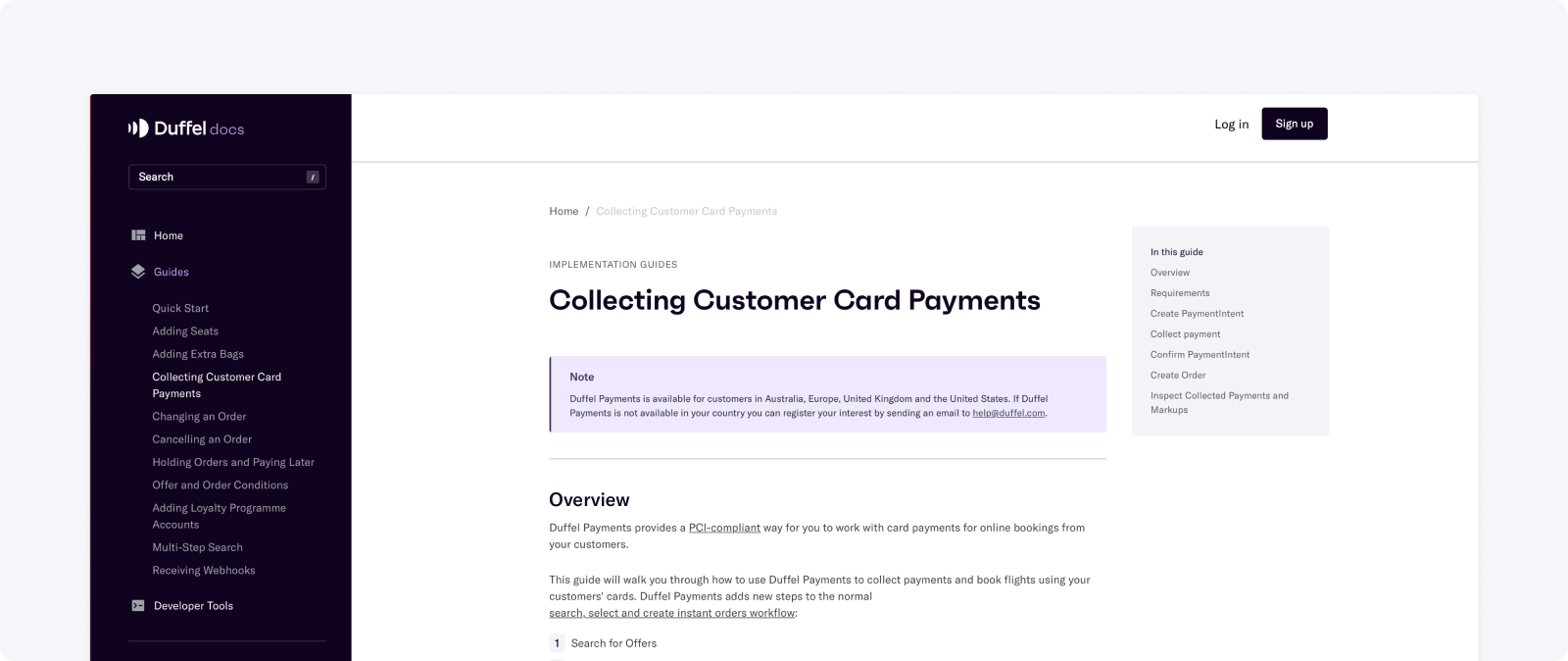
Once you're ready, you can move this over to the live environment.
Adding a markup in the Dashboard
Currently, we do not provide the ability for agents to markup fares in our Dashboard. You must integrate with the API to add markup.
How do I calculate the amount to charge my customer to account for Duffel Payment fees and currency conversion?
To calculate the amount you need to charge your customer to cover the price of an offer plus any markup, you can use this calculation:
Offer and services total amount : this is the total cost of the flight plus any extra services without Duffel fees. We always present the offer and service(s) total_amount in your settlement currency.
Markup: This is the amount on top of the flight cost that you might charge your customer to cover operational costs and any profits you want to make on the sale of the flight.
Foreign exchange rate: The foreign exchange rate would be the mid-market exchange for the day you charge your customer.
You should use an external source to get this rate (for example, https://fixer.io/ ).
If using Duffel Payments:
- Duffel applies a 2% interchange fee on transactions through Duffel Payments. You should include this in the amount you charge your customer.
- To determine the correct rate you should add a 2% markup on top of your foreign exchange rate in order to cover Duffel Payments FX fee ( fx rate x 1.02 ).
- We recommend that you add slightly more than 2% to account for the fact the FX you use might be slightly different from the one used by Duffel.
Duffel Payment fee: fee is determined based on the card country. It varies if the card is considered domestic or international, an example would be 2.9% or 0.029 .
When rounding is required you should round half away from zero .
Your balance currency is Euros (EUR), and your customer wants to pay for a flight in Great British Pounds (GBP), the foreign exchange rate between these two currencies is 0.85, they want to book a flight that costs €120.00 in total, you want to charge them €1.00 for your booking service, and the Duffel Payments fee is 2.9%. The amount would be calculated as follows ((€120.00 + €1.00) x 0.85) / (1 - 0.029) ~= £105.92 .

On average how much do travel sellers mark up flights?
Unfortunately, there isn't a one-size-fits-all when it comes to markup as it varies based on a multitude of factors. Here are a few examples:
- Domestic/international flights
- Time of year
- How far away the flight is from booking
- Competitors' prices
If you bundle other offerings such as accommodation, experiences, land transport, travel insurance, etc., you'll have more room to play around with the markup on flights as well as your other products.
Although we can't advise a specific percentage that works for everyone, you could expect on average a range between 2-6%. As you explore your integration further with Duffel, we'd be happy to have more conversations around markup.
Our latest resources
Getting started with Duffel
Follow the step-by-step guide to get started and unlock the benefits of your account.
Handling order confirmation emails
Learn how to send order confirmation emails to your customers and what you need to include.
Collecting and making payments
Learn how you and your customers can pay for flights using Duffel Balance or Duffel Payments.
Try it out on your own for free today
Sign up and start selling flights in less than 1 minute.
How Smart Mark-up Strategies Can Help You Boost Profits!

Making profit from your business venture is a clever mix of smart decisions, availability of means and opportunities. As with any travel agent, you must have plans and aim to earn greater revenue.
As a travel services seller, you are buying content from multiple suppliers and making it available to your agents and customers to choose from. Typically, every trip is searched across multiple websites before deciding on where to book from. This is true for agents as well as consumers.
If your agents don’t find the pricing lucrative enough, you will observe that your look-to-book ratios are much higher. A smart mark-up policy helps you in keeping a tight control over your margins as well as extend smart pricing to your travel agents and customers.
In this article, we explore the different opportunities available to you to add mark-ups on your services and how you can maintain a healthy margin and differential pricing for different types of content, destinations and agents.
Benefits of Mark Up Pricing
- Manage profits: Once you set a rack rate you can add a markup to boost your profits. Your markup price is an additional amount added to your price that will help you gain more revenue from the transactions.
- Competitive pricing: With a good markup strategy, it allows you to sell your inventory at a competitive price that allows you to maximize sales.
Mark-up Strategies for Travel Agencies
Mark-ups are best used to secure greater business and boost profit. Mark-up strategies play a major role in the travel business. Build a strong inventory or content from your suppliers, directly contracted hotels, activities etc. You can add a markup on these through a markup profile.
Pricing Strategies for Business
Mark up allows you to develop and implement pricing strategies that can benefit your business.
For Eg – During an event the number of people travelling increases. Let’s say the event is happening in New York. Now if you have contracted in New York and you want to ensure that these hotels need to have maximum no of sales. In this case, your pricing strategy for these particular hotels might be slightly different. You can extend extra discounts to the agents and also to the customers so these particular hotels have maximum sales. To ensure these sales go through you can reduce your markup resulting in a price that is enticing enough for the sales to push through.
Pricing Strategy for Agents
Among the agents you work with some may have a better success rate than others. Some travel agents can do better at sales than others. You can have different types of pricing strategies for each of these agents. You can create a markup profile for your highest performing travel agent. Based on their volume of sales you can offer them extra discounts. In the case of the travel agent that is performing well, you can add a lower mark-up and add higher on a travel agent whose performance is average, to compensate for your cost.
Pricing Strategy for Inventory
If you wish to sell a particular type of inventory you can add a markup or markdown to push the sales and maximize your revenue through the sales.
E.g. If you are aware that the flight ticket demands for India to Dubai are going to be higher, you can reduce your mark up and bring down the price to entice more customers and push the volume of sales.
Mark up Strategy by Currency
If you deal with different currencies, you can add a mark up to the then the conversation rate that is available through your provider.
For E.g. You deal in Dollars, AED, pounds and riyals. If your customer wants to make payment in AED, the price that is displayed will have markup added to it.
Mark up Strategy to Avoid Conflict
Mark up a profile by country helps you to avoid the conflict of pricing. You cannot add a markup for both country and city together. Since both the city and the country can bear different mark-up rates, this is done to avoid conflict and confusion between the two.
Mark up for Branch
You can add a markup for any branch or agents that work with you. Any tickets that are booked by the branches that you have associated with, you can add a markup to any sales they make. You can also add a markup to the sales your agents have. This is based on the category of your agents.
What OTRAMS Offers
OTRAMS allows you to calculate and add your markup profile, boost profit, avoid errors and save time.
Mark-up Profiles
- Users can create multiple markup profiles/tiers with this option.
- You can use or assign these profiles to agents based on their potential/ business needs.
Multiple Markups
OTRAMS allows you to add multiple markups such as Supplier Level, Country & City Level, and Branch Level.
Flight Rule
- You can add mark-up or discount to flight ticketing with OTRAMS.
- You can also define management fees for Cancellation, Issuance or Re-issuance charges
Multi-Currency System
- The currency matrix shows the list of currencies that are available in the system.
- This allows you to add a mark-up in the local currency of the traveler.
Boosting your profit with technology is made easier with the right technology provider. With OTRAMS you can have both the ease of doing business and a chance to earn more. OTRAMS by Qtech Software is the world’s leading travel ERP platform that can help you harness the power of technology to grow your business.
Get OTRAMS to Boost Your Profit with Smart Mark-Up Strategies!
Our solutions.
- DMC Software
- Travel Management Software | B2B Booking Engine
- Online Travel Agencies | B2C Booking Engine
- Travel Wholesalers & Consolidators
- Travel Mobile App
- Travel XML API Integration
- Enterprise Travel Software Development
- OTRAMS GO Plan
Booking Engines
- Hotel Booking System
- Flight Reservation System
- Transfer Booking Engine
- Car Rental Reservation System
- Dynamic Packaging Software
- Tour Operator Software
- Group Booking Software
- Miscellaneous Booking Service

Newsletter Signup Form
You may also like.
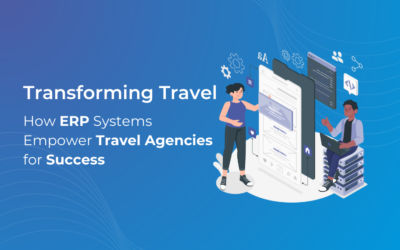
Transforming Travel: How ERP Systems Empower Travel Agencies for Success
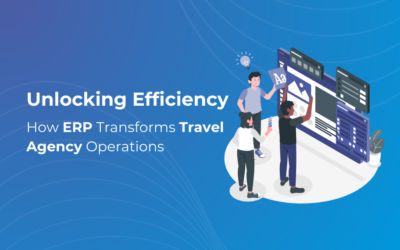
Unlocking Efficiency: How ERP Transforms Travel Agency Operations
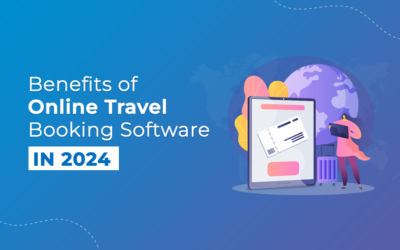
Benefits of Online Travel Booking Software in 2024
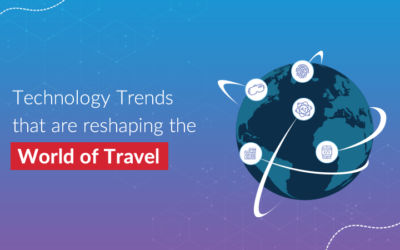
Technology trends that are reshaping the world of travel

A Complete Guide to DMC and Technology That Powers It

Importance Of Flight Rules Engine

Ready To Grow Your Travel Business?
Fill up and submit this form to reach us with your query and we will get back to you, soon.
- Google Search Engine
We Use Cookies!
Privacy overview, have a query, share it here and our team will answer them asap..


Marketing for Travel Agencies: Understanding and Surviving in the Online Travel Industry
- 16 min read
- Business , Travel
- Published: 23 Dec, 2019
- No comments Share
Running a travel business is no joke. Well, you know, saying that the travel industry is highly competitive an understatement. Even the giants with over a hundred years under their belts can fail given bad luck and poor management. Earlier this year, Thomas Cook, the British tour operator and one of the world’s oldest travel industry titans, disastrously imploded. By the time of the breakdown, the company had 19 million annual customers. Pretty impressive, right? In addition to major reasons like enormous debts and difficulties in operating airlines, its lack of online presence and a reduced demand for tour packages caused the company to go downhill. Without changing its business model and broadening distribution channels, Thomas Cook was destined to be overthrown by Booking Holdings and Expedia.

Marketing in Online Travel Agency
The market is extremely competitive, and it undergoes changes, becoming increasingly more digital. This calls for intricate approaches to marketing, distribution, and travel products themselves. Here, we will describe the distribution and communication channels, revenue management techniques, product positioning, and the technology – survival strategies all.
Understanding the travel agency market
Let’s talk about challenges first. In an industry with such a competitive nature, smaller travel agencies face three major hurdles.
- Leading players holding the market. Booking Holdings with its 41 percent share and Expedia with about 32 percent are dominating the online travel agencies market. And their shares keep growing. So, for travel agencies, it’s difficult to stay afloat without a specific niche.
- Distrust. People tend to be skeptical and even suspicious in arranging their trips. They would rather follow word of mouth, go to their old, time-tested local travel agent, or stick to larger players, even if they are not totally satisfied. So, new travel agencies have to work hard to break through the wall of mistrust.
- Invisibility. Unless a travel provider puts a lot of effort and resources into promotion, it risks staying unnoticed. Here, the choice of distribution channel plays a decisive role.
That said, midsize and small travel agencies narrow value propositions down to specific market segments, where you can become visible and win the trust of your small, but paying group of travelers. Unless you want to conquer the world and compete with Booking.com, Expedia and their owned brands, your profile of a travel agency is most likely to fit one or several of the following characteristics: Destination-specific. You target a certain destination or a region where you can supply customers with the best deals or unique products (not available on Booking.com/Expedia, etc.). It doesn’t mean that smaller travel agencies are always location-limited. But, usually, there’s a handful of destinations that can keep the business running. Price-oriented. Price has been one of the driving forces of travel purchases for years.
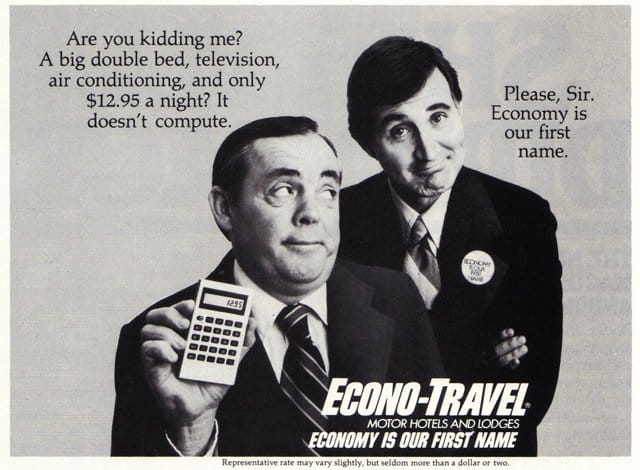
This ad, published in National Geographic by Econo-Travel hotels, dates back to 1978
Today, price remains one of the key considerations for travelers. Skift 2019 Research shows that almost 60 percent of travelers name lack of money as a factor that holds back travel decisions. This is partly confirmed by the changes that low-cost carriers bring to the table, as the destinations where LLCs start flying experience higher traveler inflow. For instance, in Krakow, Poland, the number of foreign tourists grew from 680 thousand in 2003 to 2.5 million in 2007 mostly due to the development of air travel and low-cost flights in particular. So, the basic scenario for most travel agencies is to compete by price, unless you specifically target luxury or business segments. Still, you must trump major OTAs in terms of pricing and in your target segment to survive. Specific demographic. Another way to narrow down the focus of a travel agency is to work with selected regions, budget expectations, style of travel, age groups, family/single tours, etc. The unique angle to user experience. Another way to stand out is to find new approaches to searching for and purchasing trips. While there are many online travel agencies that follow the beaten path of suggesting travelers choose destinations, dates, filter the results, and pick their travel product, numerous startups are exploring and reinventing travel booking experiences. Kiwi.com suggests a powerful engine to match non-interlined flights, create complex flight itineraries with multiple stops, and book them. Eightydays.me capitalizes on travel research fatigue, allowing travelers to define the date range of their trip and the number of cities they want to visit. The service will generate an itinerary itself, choose the cheaper options, and suggest booking.
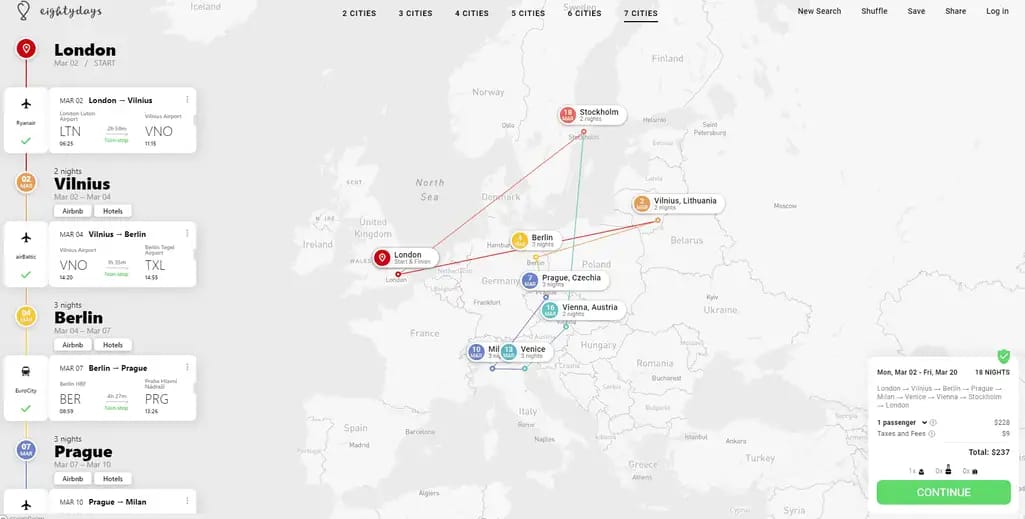
It will take days for a regular traveler to create such a complex itinerary, Eightydays cuts this to minutes
Basically, the high-level, strategic goals of modern travel agency marketing are clearly articulating a narrow segment that you address (lower prices in specific destinations, traveler region, demographics, etc.) and choosing the best tools to promote the service. So, let’s start with understanding customer segments.
Investigate and define your market and target audience
It’s likely that you already have an image of your dream traveler in mind. Or you may at least have a set of hypotheses that you must test. At this point, you want to clarify as many details as possible. Who are your travelers? First, recognize who you are targeting and how users interact with similar products in terms of their gender, age, ethnicity, income, qualification, and marital status. For instance, there are big differences in the way different age groups travel and spend during their trips. There may be different motivations. While boomers are looking for ways to relax and unwind, millennials seek more adventurous and experiential travel. Where do they go? Understanding traveler demographics will help you narrow down the number of strategic destinations and service providers that operate there. How do they look for tours and tickets and how do they book? Hold preliminary research on users’ behavioral patterns. Find out what channels they use to find a ticket or a tour. These may include different search engines, metasearch engines such as Kayak, a local offline travel agency, or a tour operator . If you aren’t new to the industry, you’ve probably heard that people use on average 2-3 travel websites to book products and make 120 to 160 visits to travel websites in general. But try to map your specific user journey by running interviews or at least checking the info in open sources. This information will help you understand the main distribution channels. How often do they travel? Exploring this question may give you some painful answers. While on average, say, Americans travel twice a year, your target group may be traveling so rarely that you can end up finding this segment is not viable.
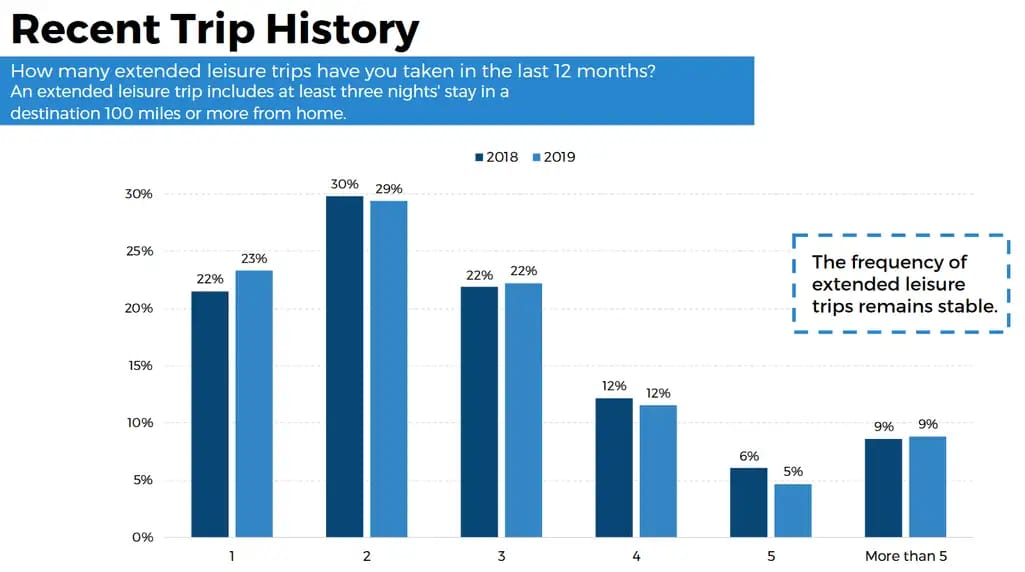
Skift, Experiential Traveler Survey , 2019
How price-sensitive are they? As we mentioned above, price sensitivity is an extremely powerful factor in travel. And sometimes, its strength looks absurd. Mark Trim, creator of a niche online travel agency in Australia that sells round-the-world flights, shares : “ We have noticed people are extremely price-sensitive to their main airfares in this climate, they’ll make a decision on a $10-20k trip depending on a $100-400 fluctuation in their airfare costs which still strikes me as quite strange. ” Most likely, even if you target luxury travel, you’ll find your audience price-sensitive as well. But it’s still worth analyzing the expenses that your target group is ready to pay for a ticket or a tour. In addition to further pricing strategy, it will also give an understanding of price ranges. At the end of this stage, you must have a clear portrait of your customers and their groups. We recommend creating user personas to document your findings and communicate them to your team. You may learn more about user personas in our article on UX research .
Analyze your competitors
Once you have an idea of your dream customers, it’s time to look at the ways they book trips with your competitors. Which competitor products do they use? Analyzing the market is also about researching competitors-to-be. Examining products similar to yours that your audience uses helps pinpoint the areas of improvement and develop a positioning statement. After defining the main competitors-to-be, it’s time to research their strengths and weaknesses. How do they win? Defining the good sides of products alike helps discover what components, characteristics, elements, and overall flow that are the most popular among users. We are not telling you to copy them, but this information can be extremely helpful to understanding user preferences. How do they fail? Finding out the rivals’ vulnerabilities paves the right way to identifying the market gap and creating the service that would be employed by users. This is how you find product/market fit . Run SWOT analysis. We’ve detailed SWOT analysis specifics in our product marketing article . Generally, this technique allows you to map your strengths, weaknesses, opportunities, and threats to prioritize the direction of further development and define how you stack up against competitors.
Establish your partnerships with service providers
Perhaps, the main assets of any travel agency are the negotiated rates and deals with end-product suppliers, airlines, hotels, tour operators, etc. While you can hook up your booking engine to global distribution systems ( GDSs ), connect with hotel suppliers , or tours and activities APIs , and call it a day, most midsize and small travel agencies exist because of their negotiated deals in a number of travel segments. The thing is with generic offers that every other travel industry player has, your product won’t be competitive. Given that you know your target destinations, value, and price sets, you should narrow down the number of providers you try to develop relationships with. It doesn’t mean though that you can’t offer flights and listings that you haven’t negotiated at all. GDSs, for instance, will provide you with generic deals that you still can sell. Eventually, you must have a pool of key suppliers ready to work with you on exclusive conditions.
Define your pricing strategy
When you have identified your target audience, found your segment, and have negotiated all your deals with providers, it’s time to think about the pricing. Obviously, marketing here overlaps the revenue model. Exploring different pricing strategies of travel agencies and diving into all the intricacies is way beyond the scope of this article. We’ll just outline the main directions of your further research. Explore standard profit margins that your suppliers have. Different regions and different suppliers may have varying profit margins. But regardless of all factors, traditionally, they are low. Again, the competition in travel is fierce and unforgiving. You may expect to get higher returns at hotels and significantly lower ones for flights. Understanding at which profit margins your suppliers operate will help you define your commissions. Find where your key suppliers distribute besides you. In a way, your suppliers are also your clients. And you have competition on the other end of the chain. You must understand the markup other travel agencies and online travel agencies have to specify your markup and balance competition with profitability. Try setting bespoke markups for all your target suppliers. We’ve described how pricing rules work at online travel agencies . They can be as simple as setting a single markup figure for all your products, but what you really want to achieve is having varying markups for different travel products, depending on competition, demand, and commissions that you receive from each supplier. Regardless of whether you have an automated booking engine, you operate mostly manually, or you have a hybrid of these two models, you must have a set of commission rules that navigate how you approach different suppliers, how you offer discounts, and how these things differ depending on distribution channels. Which is what we’re discussing next.
Determine the right distribution and promotion channels
Once you’ve shaped the strategy, it’s time to set up the distribution channels. Here are some of the best practices.
Metasearch engine
Partnering with large metasearch engines like TripAdvisor, Trivago, Kayak, or Skyscanner is arguably one of the most significant steps in making your service visible and stand out from large OTAs. Metasearch engines aggregate the deals from OTAs and supplier websites to allow travelers to compare them and choose where to book. Metasearch creates a powerful distribution channel, especially if your core differentiation is price. Ultimately, people visit metasearch engines to get an idea of available deals and compare prices. Travel agencies, usually, get featured there, based on a pay-per-click model, similar to regular ads. So, if you decide to distribute using metasearch engines, what should you keep in mind? Investigate your competitors’ rates. First, you have to know the situation on the market, what deals are presented, and how you are being ranked compared to your competitors. On learning the performance of key products, you’ll understand which offers you should submit. Given that most travelers will be choosing based on pricing, the products in your target segment and by your target suppliers must be cheaper. Use analytical tools. But how exactly are you going to check whether your deals compete well? Your competitors’ markups will be constantly changing. And your deals will change their positions as well. There must be some way to keep an eye on your performance and adjust markup to stay competitive. Many small travel agencies would manually check their segments. Another way here is to purchase the web analytic reports from some of the metasearch engines. In addition to automating all research efforts, it will also help you understand what the competition is and how your opponents rank. For instance, Skyscanner provides its Performance Analytics for Partners program . Manage your markup. To reach your final goal and be visible in the search results, you can now manage your markup or promise unique deals. The level of automation here also depends on your resources:
- You can manually check prices and manually change markups.
- You can use automated dashboards to track your performance and then manually change markups.
- The most advanced scenario is to create an automated commission engine that will keep all your markup rules and will be adjusting your margin on the go, reacting to competitor results.
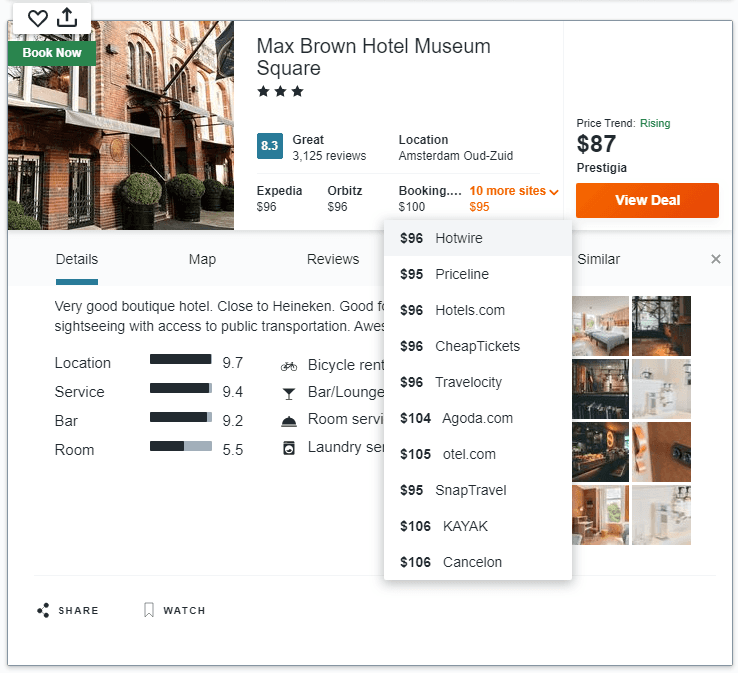
Prestigia, a small OTA with about 200 thousand monthly visitors, wins on Kayak with this hotel deal as it targets boutique accommodation
Consider the core value of each engine. Each of the major metasearch engines has its own advantage. Users all around the world appreciate Google for speed, simplicity, and the fact that their flight metasearch widget appears on the search engine panel if you sell flights. Kayak is extremely valuable for its “price forecasting.” And the core value of Skyscanner, in addition to rapidly rising popularity, is greater coverage of European destinations.
Search engine
About 30 percent of travelers use Google and other search engines to find their deals. So, investing in this channel is also a viable strategy. Blogging. By writing a good, competitive, and compelling copy, you are not only making your service visible to search robots. The extra value here is that you are attracting customers with an educational and engaging read. It encourages their informative decisions and improves your chances that they accept your offer. A great example is TripMyDream, a small Ukrainian online travel agency. They’ve created a blog that eventually became the largest travel media in the country. The content includes articles on their best deals, the most popular destinations, local attractions, and the latest travel industry news. Dedicated landing pages for target deals. There’s another common approach that many modern OTAs practice. You can create dedicated landing pages for your target deals and special offers. When writing copy for them, focus on specific keywords that people use to find these deals. This will allow search robots to find your pages and rank them higher. Besides the copy itself, you may add a booking interface to these pages, a price-picker calendar, product ratings, etc.
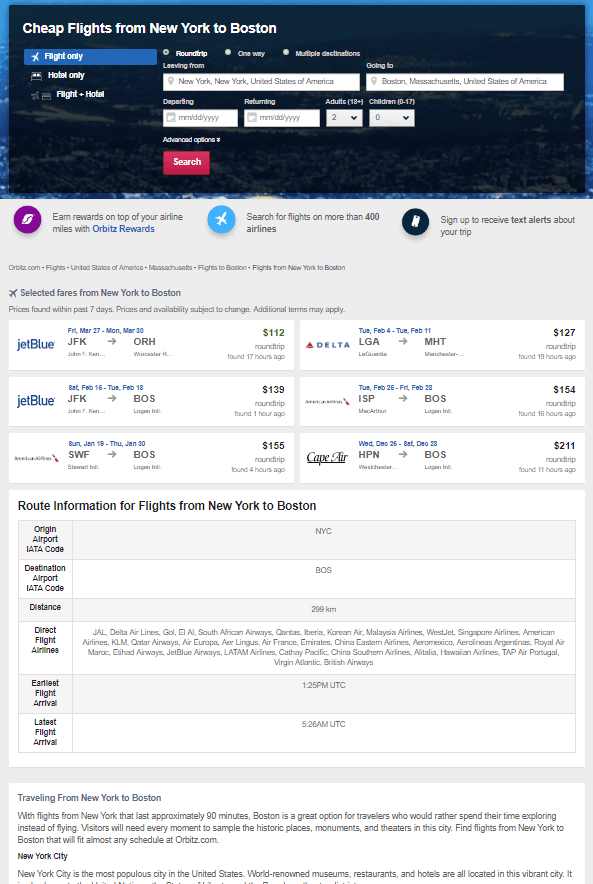
Orbitz has dedicated landing pages for hundreds of their deals and packs them with all useful information that a traveler may need: a booking widget, selected fares, basic information, and even short copy describing the trip
Check our case study on the technical side of generating such pages. Invest in SEO. The technical side of search engine optimization activities can also bring much to the table. Basically, SEO activities consider two main things:
- Internal activities to meet technical standards of search engines. These usually include installing tools like Google Console and Google Analytics, working with meta tags, reviewing a website for the right page redirection, code errors, and others.
- External activities usually include working with keywords, texts in general, and acquiring backlinks from other websites.
It’s worth mentioning that no external activities may begin without finishing all internal ones. Fundamentally speaking, the main goal of SEO activities is showing the search engine that you understand traveler problems and know how to solve them.
Email marketing
Being probably one of the oldest selling channels, email marketing still works. The travel industry is no exception. The main goal of email marketing is not only to attract but to raise a customer’s interest and retain existing travelers. Collect email accounts. The first step is gathering user emails. The easiest and most basic approach is allowing travelers to sign up for additional services like price-drop alerts and valuable newsletters. Be aware of GDPR requirements . Pick the right mailing tool. A perfect mailing agent provides emailing automation and customized segmentation (age, price expectations, departure airports, etc.). Also, it must allow for analyzing user behavior, such as opening rates, a number of clicks, or even bounce rate. Tools like MailChimp or ActiveCampaign would be a good start. Track behavior and make customized offers. Trace user behavior to understand what travel products and price range your readers usually react to. This will help you better segment customers. At the same time, you may also build your entire strategy on suggesting customized offers by email subscription only, as Moonfish does. The only thing a user has to do is subscribe to emails and pick their home airport. Moonfish will send you notifications on destinations available from there. Hot deals and discounts. You can use discounts as one of the most powerful selling points, stressing urgency or time-restricted conditions.
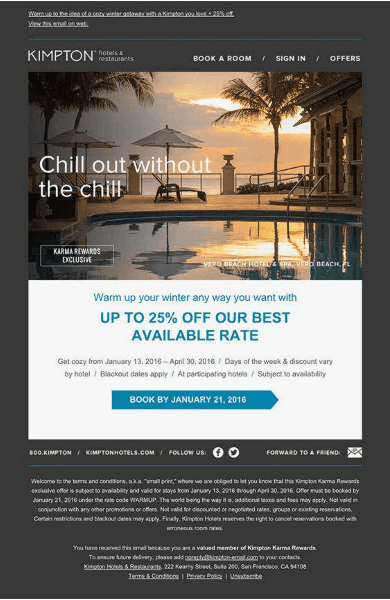
One of the great examples of submitting discounts was Kimpton Hotels and Restaurants. The discounts promoted the unpopular post-Christmas holiday season
You can offer generic hot deals but also consider customizing them to a customer’s preferences, such as destination or type of activities included. Or you may even suggest the coverage within the preferable direction. Bundled options. To show care for a customer, you may also create so-called bundles – services and activities to extend and improve their experience. Say, your customer has booked a flight. In your follow-up email, you may suggest car rental services, an apartment, local restaurants, local attractions, and places to visit. Holiday specials. Some people plan their trips on holidays. In your holiday-bound emails, you can step back from a behavior-based approach and include diversified offers, just like Kayak does.
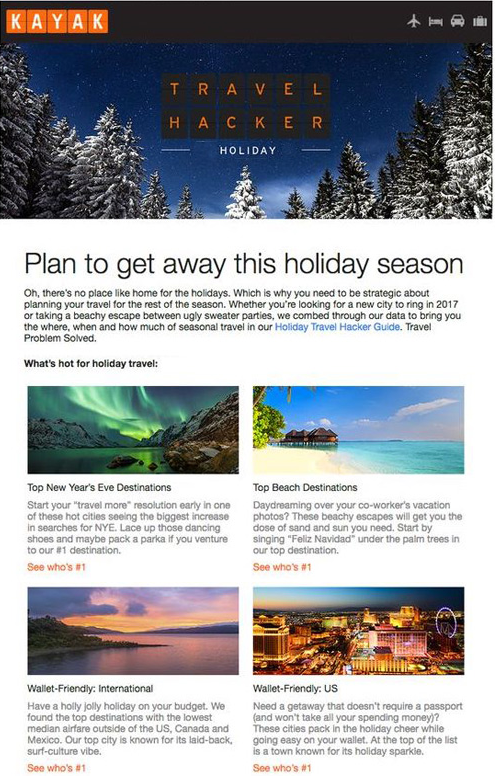
As you can see, there are both wallet-friendly and luxurious destinations and tour packages
You might also congratulate your customers on their birthday by suggesting special discounts or giveaways to show appreciation for using your services.
Web adverts
Web banners and links also still work . But things aren’t that simple. Even though adverts remain one of the most straightforward ways to attract the right audience, the way you do web advertising can be tricky in travel. Google search ads. Yes, those top links on the search page. Google search adverts can be effective if you run them for very specific keywords that don’t compete with the major OTAs and metasearch engines. Since displaying those depends on a sophisticated bidding algorithm that considers multiple factors – including the price you’re ready to pay per click and the way Google thinks that your page is helpful and relevant – competing with major brands may be tough here. On the other hand, if you’re lucky enough to have a number of very specific segments and deals that aren’t advertised by large OTAs, Google ads are a great way to start. An interesting example here comes not from an OTA but a hotel chain, Red Roof . They realized that competing with Kayak or other heavyweight players in Google is expensive. So instead, they capitalized on stranded passengers after flight disruptions and targeted keywords like “hotels near O’Hare Airport” with mobile search only. There were a number of other smart tricks like tracking flight cancelation data using flight APIs in real time and matching it with geo-targeting in their ad campaigns. Eventually, they got 266 percent growth in nonbrand mobile bookings. Retargeting. Sometimes it happens that a user has visited your website, searched for some flights or tours, but didn’t book. With retargeting adverts, you can remind them to do so. But here’s the trick. Given that travelers usually immerse in deep research, it’s likely that they checked your website just to browse. Some tech-savvy, online travel agencies and travel tech startups like bd4travel embark on data-science-based personalization of ads defining which of the visitors are likely to make a purchase to target ads at them. How does it work? Basically, you set up a visitor behavior tracker on a website, analyze their actions, and then choose which of them are worth retargeting. This will help you spend your retargeting budget efficiently, rather than showing your ads to everyone browsing. You may check our case study on machine-learning-driven personalization in an OTA or read a dedicated article that describes how personalization in travel works . Adverts on social media. Social media isn’t much different in terms of the approach to adverts. You’re still looking at highly targeted campaigns. And the good thing is that Facebook and its own brand, Instagram, are famous for deep and granular tools for segmenting your target audience. On top of that, Facebook has a dedicated travel-focused toolset for their platforms and audience network with learning
Video blogging and other social media
Travel bloggers are becoming increasingly popular with the audience. Travel agencies also try to capture this opportunity with useful and entertaining social media and video blogging. So, here are some general directions that you may consider. Document your social media strategy. Similar to blogging on your website, only a systematic approach to social media will work. So, plan out the platforms that you’re going to use and be prepared to post regularly. Having an editorial calendar is also a smart move. Promote the place, not your service. At the end of the day, most people go to other countries to get new experiences. It’s not about staying in an apartment or by the pool. It’s about getting impressions that they have never had before. So instead of promoting hotels or airlines, tell more about destinations. Intimate and cozy cafeterias, locales to visit, and hidden gems of local attractions – not overcrowded with hundreds of tourists – will surely broaden the horizons for your customers. Give life hacks. Many of your potential customers are looking for advice. So, you may create useful videos, both general and destination-focused. You may give some tips on packing or explain how to choose the cheapest flights and apartments in your target destinations, or maybe shoot a video or write a post explaining how transportation works in a particular city. Invest in great imagery. A widespread opinion shared by travel agents is that posts with great images of the destination attract more attention and turn out to be more effective than posts without them. This is especially relevant for Twitter and Instagram. Prepare to run customer service on social media. Most of the feedback, especially the negative variety, you’re going to receive on social media and review platforms like TripAdvisor. So, dedicate a customer service or PR specialist who will be instantly reacting to feedback and engaging in solving traveler problems. If you do look authentic and caring, it will become a powerful driver of traveler trust.
Final recommendations
Running a business in a constantly changing industry is an evolving process. Someday, techniques that worked before will have to be updated, so you’ll have to monitor where the travel sector is going. We hope this article gave you a few ideas on making it as a travel agency. Here are our final tips. Know your segment and target it. The better you understand your travel segment in regard to destinations, customer groups, and deals, the more channels and hacks you can find to stay visible. Constantly develop your partnerships. Your suppliers and exclusive deals that you have with them are your main assets. At some point, growing the number of partnerships equals the growth of your business. Invest in custom technology. Although you’ll find hundreds of tools available for travel agents and online travel agencies, having your own unique angle for reaching travelers is proven effective by many cases, some of which we described in the article. More on technological changes in OTAs here: https://www.youtube.com/watch?v=94AaF1VmTsc Implement-iterate. Marketing activities aren’t a single campaign. It’s an iterative and ongoing work. To survive, you have to constantly track your performance, monitor the market, and discover new distribution channels and opportunities.

Travel Fam Trip
The Best Travel Fam Tips
- Travel Fam Tips
How Travel Agencies Earn Money: A Complete Guide To Their Revenue Streams

Have you ever caught yourself wondering how travel agencies manage to stay afloat in this era of easy-peasy DIY trip planning? You’re not alone – it’s a question that has crossed my mind more times than I can count, especially after learning that travel agencies in the U.S. pulled in a whopping $17.3 billion in 2021! Like many of you, I was itching to peel back the curtain on this tenacious industry and get a glimpse at their revenue-generating magic tricks.
So buckle up and come along for the journey; our guide is your all-access pass to demystifying how these travel maestros keep their cash register singing.
Key Takeaways
- Travel agents get commissions from airlines, hotels, and other suppliers for bookings made for their clients. These commissions are a big part of how they earn money.
- Agencies also charge service fees for personalized itinerary planning and handle complex travel arrangements, adding another income source.
- Offering niche services like luxury eco – tourism or themed vacations allows travel agencies to attract specific types of travelers and create additional revenue opportunities.
- Big travel agencies use their size to negotiate better deals with suppliers and provide diverse services worldwide, helping them maximize profits.
- To increase earnings further, travel agents can promote exclusive deals on social media, network with local businesses for corporate arrangements, and consistently enhance their industry knowledge through training.
The Evolution of Travel Agencies

Travel agencies have evolved over time, from traditional storefronts to more modern and flexible home-based models. With the rise of online booking platforms, travel agents have had to adapt their business strategies to stay competitive in the industry.
A Brief History
I’ve seen the landscape of travel agencies transform over time. In their early days, these agencies operated as key gatekeepers between travelers and transportation providers like airlines and train companies.
They thrived on commissions from bookings, wielding exclusive access to reservation systems that were out of reach for the general public.
Over the years, travel agents have had to adapt quickly due to technological advancements. The internet burst onto the scene and suddenly, flight tickets and hotel rooms were just a click away for anyone with web access.
This revolution forced agencies to reevaluate their value propositions and dig deeper into personalized services where they still held an edge over digital platforms.
Shift in Business Models
Travel agencies have had to rethink their approach to stay competitive. In the past, they primarily earned from commissions on bookings for flights, hotels, and tours. Now, with the rise of online travel platforms and do-it-yourself booking options, traditional commission-based models don’t cut it anymore.
Agencies are turning towards more diverse business models that focus on value-added services. They’re charging service fees for personalized itinerary planning and leveraging relationships with providers to offer exclusive deals.
Some even create unique travel experiences that you can’t find elsewhere or cater to niche markets like luxury eco-tourism or adventure travel. By adapting in these ways, they keep their edge in a tech-driven market where travelers demand more control and customization.
Transition to Home-Based Agencies
Making the switch to home-based agencies marked a significant change in the travel industry. I traded my office for my living room, embracing flexibility and personalized service that clients love.
This move cut down on overhead costs dramatically, boosting profit margins without sacrificing quality. By leveraging technology and social media, I can connect with customers anywhere at any time.
Adapting quickly became crucial once I ditched the traditional storefront. Now, fostering relationships with clients and offering tailored experiences is at the core of what I do. It feels good to provide value that goes beyond just booking trips; from crafting unique itineraries to being there when plans go awry – nothing beats the personal touch I can give from my home setup.
Diversifying Income Streams
Diversifying income streams is essential for travel agencies to maximize their earnings and remain competitive in the industry. By offering a variety of services such as customized itineraries, niche travel packages, and corporate travel management, agents can tap into different market segments and revenue sources.
This not only increases their potential for earning commissions from airline and hotel bookings but also allows them to charge service fees or markups on specialized offerings. Moreover, exploring new sales strategies and partnerships with tour operators can further diversify income streams and create additional opportunities for generating profits.
In conclusion, diversifying income streams enables travel agencies to adapt to changing market demands and capitalize on various revenue sources beyond traditional booking commissions.
How Travel Agencies Make Money

Travel agencies make money through various revenue streams, including commissions from airlines and hotels, service fees, and custom itinerary services. To learn more about the different ways travel agents earn money, keep reading!
Breakdown of Revenue Streams
Travel agencies earn money through various revenue streams, including:
- Commission from Suppliers: Travel agents receive a commission from airlines, hotels, car rental companies, and other suppliers for bookings made on behalf of clients.
- Service Fees: They charge service fees for the time and expertise invested in creating customized itineraries and handling complex travel arrangements.
- Tour Packages: Selling pre-packaged tour deals gives them a margin on the price difference between what they pay the supplier and the package price sold to the client.
- Corporate Services: Business travel management generates income through negotiating corporate rates with suppliers and providing expense management solutions.
- Ancillary Products: Earning commissions from selling travel insurance, visa processing services, and other ancillary products adds to their revenue stream.
- Incentives and Bonuses: Some agents receive incentives or bonuses based on achieving sales targets set by suppliers or consortiums they are affiliated with.
- Group Booking Markups: Organizing group tours enables them to negotiate favorable rates with suppliers and earn markups on group bookings.
Corporate Travel Agencies
After understanding the revenue streams in travel agencies, corporate travel agencies stand out as a significant source of income. These agencies specialize in managing business-related travel for organizations.
They earn money through service fees charged to businesses for booking flights, accommodations, and other logistics required for corporate trips. Additionally, they often negotiate contracts with airlines and hotels to secure discounts or commissions on bookings made for their clients.
Moreover, corporate travel agencies can generate revenue from providing consultancy services that optimize their client’s travel spending through cost-saving measures like bulk purchasing deals and data analysis to identify better booking options.
Leisure Travel Agencies
Leisure travel agencies generate income through commissions on bookings, service fees, and markups on tour packages. They earn a percentage of the total cost when clients book flights, accommodation, or tours through them.
Additionally, travel agents may charge service fees for custom itineraries and specialized services such as destination weddings or adventure trips. Furthermore, leisure travel agencies often markup the price of tour packages provided by suppliers to achieve a profit margin.
By diversifying their revenue streams and offering niche services such as luxury travel experiences or themed vacations, these agencies can maximize their earnings in an increasingly competitive market.
Custom Itineraries and Niche Services
When creating custom itineraries and niche services, I focus on curating unique travel experiences tailored to each client’s preferences. By offering specialized packages such as adventure travel, culinary tours, or eco-friendly getaways, I can meet the specific needs of discerning travelers.
This personalized approach allows me to differentiate my services in a competitive market, attracting clients seeking exclusive and authentic experiences.
I leverage my expertise to craft bespoke itineraries that cater to niche interests like cultural immersion, luxury travel, or off-the-beaten-path destinations. By tapping into these specialized areas, I can provide added value and stand out from mass-market offerings.
Big Travel Agencies
Expanding beyond niche services, big travel agencies play a significant role in the industry. They often have a substantial market share and boast extensive networks with various suppliers such as airlines, hotels, and tour operators.
Scaling their operations to reach a broader audience, these agencies leverage their brand recognition to negotiate favorable terms with suppliers, which in turn impacts their revenue streams significantly.
By tapping into economies of scale and offering diverse services across different regions or continents, large travel agencies can maximize profits while providing comprehensive support to a wide array of clients.
Taking advantage of their size and resources, big travel agencies are able to offer competitive pricing on package deals due to wholesale buying power. Additionally, they can invest in cutting-edge technology solutions that streamline processes for both employees and customers – from booking platforms to customer management systems.
Maximizing Earnings as a Travel Agent
To maximize earnings as a travel agent, understanding the different types of travel agents and tips for increasing income are essential. Want to know more about how you can increase your revenue as a travel agent? Keep reading to learn all about it!
Different Types of Travel Agents
There are various types of travel agents, each specializing in different areas such as corporate travel, leisure travel, custom itineraries, and niche services. Corporate travel agents focus on providing business-related travel services such as booking flights and accommodations for employees attending conferences or meetings.
On the other hand, leisure travel agents cater to individuals seeking vacation packages, cruises, or adventure trips. Some agents specialize in creating customized itineraries tailored to clients’ specific needs and interests while others focus on niche services like destination weddings or eco-tourism.
Some big agencies offer a wide range of services; smaller home-based agencies often provide personalized attention to their clients by focusing on specific niches or customized offerings.
Tips for Increasing Income
To increase income as a travel agent, I suggest the following:
- Leverage social media to promote exclusive travel deals and engage with potential clients.
- Offer personalized services and carefully curated itineraries to attract high – paying clients.
- Network with local businesses to establish partnerships for corporate travel arrangements.
- Invest in ongoing training and education to stay updated on industry trends and destination knowledge.
- Implement a referral program to incentivize existing clients to recommend your services to others.
Understanding Commissions
As a travel agent, understanding commissions is essential for maximizing earnings. Commissions are the primary source of income for many travel agencies and agents. They are typically earned from booking flights, hotels, car rentals, and other travel services on behalf of clients.
These commissions can vary based on the travel provider and type of service booked. It’s crucial to have a clear understanding of commission structures offered by different suppliers in order to negotiate better deals and maximize profits.
Travel agents should also be aware of any incentives or bonuses offered by suppliers, as these can significantly boost earnings. Building strong relationships with preferred suppliers can lead to higher commission rates and exclusive offers for clients.
Creating Niche Services
As a travel agent, I develop niche services to cater to specific customer needs. This may involve creating specialized packages for unique destinations, such as eco-tourism adventures or culinary tours.
By offering niche services, I can differentiate my agency from competitors and attract clients seeking tailored experiences. Additionally, developing expertise in niche areas allows me to provide valuable insights and recommendations that set me apart as an industry expert.
My goal is to identify underserved markets and design custom itineraries that resonate with those audiences. This approach not only enhances customer satisfaction but also boosts my agency’s revenue potential through premium service fees and exclusive partnerships with niche suppliers.
In conclusion, travel agencies can generate income through various revenue streams, including commissions from bookings and service fees. They have adapted business models to diversify their earnings by offering custom itineraries and niche services.
Maximizing earnings as a travel agent involves understanding different types of agents and tips for increasing income. Overall, the profitability of travel agencies is dependent on their ability to adapt to changing market dynamics and offer unique value to clients.
1. How do travel agencies make money?
Travel agencies make money through commissions from airlines, hotels, car rental companies, and tour operators when they book travel services for clients.
2. Can I save money by booking directly instead of using a travel agency?
In some cases, you may find lower prices by booking directly; however, travel agencies often have access to special deals and can provide valuable expertise and support.

3. What are the different revenue streams for travel agencies?
Travel agencies earn revenue through commissions, service fees charged to clients, selling travel insurance or packages, and through partnerships with other businesses in the industry.
4. Do all travel agencies charge service fees?
Not all travel agencies charge service fees; it varies based on the agency’s business model and the complexity of the trip being planned.
5. How much commission do travel agents receive?
Commissions for travel agents vary but typically range between 10-15% of the total booking cost depending on the type of service booked.
Related News

Why Do Travel Agents Get Better Deals? The Truth Behind The Savings

Uncover The Best Travel Agent Fam Trips To Africa: Explore The Wonders Of Kenya, Tanzania, And More!
You may have missed.

Why Taking Family Vacations Is Vital For Building Strong Bonds And Creating Lasting Memories

How Do Disney Travel Agents Earn Their Income?

How To Successfully Market Yourself As A Travel Agent And Gain New Leads
CUSTOMER SUCCESS STORY
Productive Serves Makerstreet as a Single Source of Truth
Makerstreet is an Amsterdam-based collective of agencies with over 300 employees in four offices.
Agency Valuation Calculator Report
See the 2023 Global Agency Valuations Report
Book a Demo
Try Productive
{{minutes}} min read
The Easy Way to Calculate Markups on Billable Expenses
Kresimir Simicic
September 26, 2018
It’s easy to get lost and forget things when you’re handling a bunch of receipts for third party expenses.
This often causes problems for agencies, the worst ones being a loss of revenue and profit. If your projects come with a lot of out-of-pocket expenses, read this article. Examples of out-of-pocket expenses A typical example of a project packed with expenses would be event organization. Here are the most common tasks agencies need to take care of when organizing events for their clients: 1. Catering – Make sure attendees have something to eat 2. Music – Find a good a band to entertain everybody 3. Marketing – Print materials so people know who sponsored the event 4. Venue – Find a suitable place and get it decorated with balloons The list goes on… Examples of out-of-pocket expenses can be found on all types of projects, not only events. They can occur for software development agencies, marketing agencies and consultancies alike. Sometimes you may need to hire a lawyer or an accountant, pay for software licenses or get a freelancer to do the copywriting. Ultimately, all of these expenses can affect both the revenue and profit. This is because they can be either billable or non-billable . So, what is the difference? Non-billable expenses In the case where all expenses are non-billable, things are quite simple. A budget was agreed to before the start of the project. Every expense that occurs during the project is covered with the money coming out of that budget. Naturally, this only generates cost, meaning that the revenue stays the same but the profit reduces with every added expense. Billable expenses Agencies often bill out-of-pocket expenses to clients. There are several cases, two of which are the most common: 1. Billing the actual cost – if an expense amounts to $100, the agency can ask their client to cover that cost 2. Adding a markup – if an expense amounts to $100 and the agency markup is 5%, the client will end up paying $105. In a nutshell, adding a markup, in this case, has generated 5% extra revenue for the agency. Expenses can accumulate quickly, and there should be a good mechanism in place that allows you to manage this. Productive handles out-of-pocket expenses with ease, allowing you to tackle both billable and non-billable ones in a couple of clicks.
Get Full Control Over Your Budget
Manage your expenses and streamline repetitive tasks with an all-in-one agency management software.
Start Free Trial
Book a demo
Managing out-of-pocket expenses in Productive
Whenever you add an expense to a Productive budget, you can mark it as either billable or non-billable. Non-billable
Will not be billed to the client
The revenue will stay the same
The expense will not show up in the invoice
Billable
Will be billed to the client
The revenue will also increase
The expense will show up on the invoice
Productive allows you to add your default markup when adding an expense – in this case, 5%. All you have to do is add this 5 % and the billable amount is calculated automatically, saving you the trouble.
Arming yourself with the right tools can make things way easier in the long run. Managing expenses can be extremely tedious and leaves a lot of room for error. The way we manage your expenses in Productive not only makes your work easier but also ensures you stop losing money where you shouldn’t.
VP of Business Development
Related articles
One task, one assignee: why apple’s approach to project management works, create a client communication portal for your agency, five productive reports every agency should use.
Building Productive
Brand Guidelines
Trust Center
Integrations
Automations
Permission and User Access
Software Development
Marketing Agency
Business Consultancy
Design Studio
In-house Team
Customer Stories
End-to-end Agency Management
Agency Resource Management
Product Updates
The Bold Community
Workflowmax
TOP GUIDES & TOOLS
Resource Planning Guide
Capacity Planning Guide
Workforce Planning Guide
Workload Management Guide
Billable Hours Guide
Project Budget Guide
Revenue Operations Guide
Agency Valuation Calculator
Billable Hours Calculator
© The Productive Company
Privacy Policy
Terms & Conditions
We need your consent to continue
Necessary cookies
Cookies for the basic functionality of the Productive website.
Functional cookies
Cookies for additional functionality and increased website security.
Targeting cookies
Advertising and analytics service cookies that create day-to-day statistics and show ads on their site and on the advertiser’s partners websites.
Save changes
Manage cookies and help us deliver our services. By using our services, you agree to our use of cookies.
Try Productive for free
Free 14-day trial. No credit card required. Cancel any time.
Already using Productive? Sign in with an existing account
The Complete Guide to Travel APIs in 2024: Key Opportunities for Growth
Travel APIs have emerged as a critical technology for powering innovation across the hospitality and tourism sector. This comprehensive guide will explain what travel APIs are, their benefits, examine leading use cases amongst major brands, and provide best practices for adoption. By the end, you‘ll understand how to harness travel APIs as strategic tools to enhance customer experience and unlock new revenue streams.
Introduction: The Fast-Growing Travel API Market
A travel API (application programming interface) enables software developers to integrate directly with databases of travel data like hotel rooms, flights, rental cars and more. The API pipes this data into apps and websites in real-time.
For example, instead of a hotel website having static room rates listed, its integration with a hotel API allows displaying live rates and real-time availability obtained from the hotel‘s property management system.
The travel API market has witnessed massive growth as online booking platforms utilize these B2B connectors to streamline the lookup and reservation process. Annual travel API transactions are predicted to reach 3.6 billion by 2024 , up from 1.5 billion in 2019 according to Phocuswright.

APIs allow travel brands to quickly distribute inventory and services across channels. The result? Travel shoppers enjoy an always up-to-date view of the latest deals in one place, enabling easy comparison booking.
Let‘s examine the capabilities and applications of travel APIs across hotels, flights, rental cars and attractions. We‘ll spotlight leading examples along with tips to ensure successful API adoption.
Key Benefits of Travel APIs
Here are some of the ways travel suppliers and online booking platforms utilize APIs:
For travel suppliers:
- Distribute inventory across 100s of online travel agencies, metasearch sites etc.
- Enable direct bookings from search engines like Google
- Simplify integration with third-party distribution channels
- Receive real-time reservation updates across sales channels
- Analyze booking data, customer trends to optimize offers
For online travel agencies & metasearch engines:
- Provide real-time pricing and availability across travel products
- Enable customized bundling of flights+hotels+cars into packages
- Boost comparison shopping experience for travelers
- Rapidly add new suppliers via API integration
- Assemble complete trip itineraries spanning activities, tours, etc.
Research by Skift shows that travel shoppers now visit 38 websites on average before booking a trip. Travel APIs allow consolidating real-time data from numerous suppliers onto far fewer platforms, reducing search friction.
Top Travel API Use Cases
Let‘s dive into some leading applications across sectors:
1. Hotel APIs
Hotel APIs enable direct connectivity between hotel reservation systems and external sales/distribution channels via real-time data transfer. Common capabilities include:
- Look up live room rates, room types, amenity info
- Check real-time availability for upcoming stay dates
- Compare prices across room categories
- Complete new bookings and receive confirmation
- Retrieve reservation details for a booking ID
Google Hotel API
One of the most widely adopted hotel APIs globally is the Google Hotel API . It boasts the following features:
- Indexes 500k+ hotels in 200+ countries
- Updates rates/availability 3x daily for near-real-time accuracy
- Free version has basic functionality while paid tiers enable advanced features
- Offers flexible commission models for partners
- Powers hotel search across Google platforms like Google Travel, Google Flights and Google Maps
The Google Hotel API is used by many major online travel agencies and metasearch engines to integrate hotel search capabilities. Its extensive reach and direct tie-in with Google search makes it appealing.

Providers like booking portals can also become affiliate partners to earn commission when users book via the API. Independent hotels benefit by exposing their rooms to Google‘s vast customer base. But hotels must regularly update rates/availability for best results – a time cost.
2. Car Rental APIs
Rental car APIs allow programmatic access to live inventory across leading agencies for lookup and bookings. For users, this means:
- Review car availability across pickup locations
- Check rates across car types/categories
- Compare prices across rental providers
- Reserve the best match for travel dates
Providers like Trawex offer rental car APIs combining inventory from 50+ suppliers including Hertz, Avis and Europcar:
Trawex Car Rental API
The Trawex API enables partners to integrate rental car booking capabilities via:
- Real-time car availability checks for precise quotes
- Single API for major brands allowing easy consolidation
- Direct Reservations to issue confirmed bookings instantly
- Pricing Markups to set profit margin on rentals
- XML/JSON output for smooth integration
Partners can become an authorized reseller by subscribing to the API. Common use cases include travel marketplaces, price comparison sites, tour operators and travel management companies.

Rental suppliers benefit from expanded distribution reach while partners can differentiate by bundling rental cars into complete trip packages. Testing is crucial to ensure accurate quotes.
3. Flight APIs
Airline APIs empower partners to look up live flight schedules, availability, pricing and make bookings via real-time connectivity. Common capabilities:
- Browse scheduled flights by route, dates, number of passengers
- Check availability of seats on desired flights
- Review real-time fare details across cabins
- Reserve and purchase flight tickets directly
- Access additional data like aircraft details, baggage allowance, arrival times etc.
Leading GDS providers like Amadeus and Sabre offer flight APIs with global scope:
Amadeus Flight Offers API
The Amadeus Flight Offers API enables accessing bookable flights from 500+ airlines including full-service and low-cost carriers.
Its features include:
- Fares and availability reflecting live airline inventory
- Optimized shopping experience via single API call
- Retail and corporate booking use cases
- Caching options to limit calls and costs
- Available in test environment to refine integration
Partners can subscribe to the API for usage-based pricing. The API powers flight search and booking for many top OTAs.

This delivers mutually beneficial scale – airlines expand their virtual shelf space while booking sites offer comprehensive flight inventory in one place. Rigorous load testing is vital before launching globally.
4. Tour and Activity APIs
Travel brands can tap tour and activity APIs to showcase available attractions, tours and events across destinations. Common capabilities include:
- Browse things to do like museums, attractions, tours
- Check availability and reserve spaces in real-time
- Book rental cars, flights and hotels alongside activities for full trip planning
Providers like TrekkSoft and Ticketmaster supply leading activity APIs:
TrekkSoft API
The TrekkSoft API allows tour operators to distribute products across third-party sites. Its features include:
- Real-time availability checks and reservations
- Support for 50+ languages and 120+ currencies
- PCI compliant payments via the API
- Rate plans, discounts and promo codes -pickup locations, travel times, and more
This expands direct packaged bookings beyond a provider‘s website.
Ticketmaster Discovery API
With over 500 million tickets sold annually, Ticketmaster offers a range of APIs. The Discovery API enables:
- Event discovery by location, keyword, genre etc.
- 150k+ events across concerts, sports, arts and more
- Reviews, seating maps and other event details
- Inventory availability checks in real-time
Partners can integrate event discovery and ticketing into a cohesive trip booking workflow.

Activity APIs turn static destination content into bookable products that add value. Providers benefit from increased distribution and commissions.
Choosing the Right Travel API
Here are some key factors when evaluating travel APIs:
- Coverage: Number of hotels, flights, rental cars, events indexed
- Availability : How frequently is data refreshed for real-time accuracy?
- Capability : Can you complete bookings or only search availability?
- Cost : Per-call pricing? Monthly subscriptions? Account tiers?
- Output : Are output formats (JSON, XML) appropriate for your usage?
- Support : Documentation quality? Sample code? Technical assistance?
Leading GDS providers like Amadeus, Sabre and Travelport offer extensive air, car, hotel and rail APIs. But niche suppliers often have the best region-specific content.
Booking Holdings (owns Priceline, Kayak, Agoda) and Expedia Group (Expedia, Travelocity) also offer proprietary travel APIs. Evaluating your unique needs is key before selecting.
Best Practices for Travel API Success
Here are some top tips to ensure maximum value from travel API adoption:
- Start small : Limit initial scope to a single provider or geography before expanding
- Phase launches : Rollout new integrations incrementally to pinpoint issues
- Test extensively : Rigorously test APIs to catch bugs before they impact customers
- Monitor adoption : Analyze API usage metrics to refine product-market fit
- Promote capabilities : Educate users on new features enabled by your API platform
- Stay compliant : Ensure API usage follows terms of service and locality regulations
- Watch dependencies : If your platform relies on external APIs, have fallback plans in case of downtime
- Plan for scale : Stress test API loads on staging environments before launch
- Automate post-launch : Use API testing tools to monitor performance 24/7
With the right API strategy, travel brands can provide customers seamless, accurate experiences across booking journeys.
The API-Driven Future of Travel is Here
Travel APIs have revolutionized how brands build innovative digital experiences in hospitality and tourism. By tapping into continuously updated data from diverse travel suppliers, platforms can deliver always-on convenience:
- For customers : Comparison shop the latest deals in one place and book in minutes
- For suppliers : Distribute inventory widely to boost bookings across channels
- For travel marketplaces : Assemble complete trips spanning flights, hotels, cars, activities and more
From major online travel agencies down to individual hotels and tour providers, travel APIs enable businesses to focus on where they truly add value. And conceal the complexity behind sleek customer experiences.
While the capabilities are compelling, realizing the full benefits does require diligent API testing and monitoring. This ensures customers never see an outage or error caused by bad API implementations.
With a thoughtful API adoption strategy, travel brands can future-proof their platforms to meet rising digital demands. By harnessing the collective power of the wider travel ecosystem, companies can accelerate innovation and take customer service to new heights.
I am Paul Christiano, a fervent explorer at the intersection of artificial intelligence, machine learning, and their broader implications for society. Renowned as a leading figure in AI safety research, my passion lies in ensuring that the exponential powers of AI are harnessed for the greater good. Throughout my career, I've grappled with the challenges of aligning machine learning systems with human ethics and values. My work is driven by a belief that as AI becomes an even more integral part of our world, it's imperative to build systems that are transparent, trustworthy, and beneficial. I'm honored to be a part of the global effort to guide AI towards a future that prioritizes safety and the betterment of humanity.
Similar Posts
Hello there let‘s explore seo monitoring together.
Search engine optimization can seem complicated at first. But don‘t worry! In this guide, I‘ll walk…
Dogecoin: The Rise and Fall of the Joke Coin
Dogecoin, the tongue-in-cheek cryptocurrency featuring the popular Shiba Inu meme dog, exploded into the mainstream in…
Is AutoGPT Really Free to Use? An AI Expert‘s Perspective
As an artificial intelligence expert, I get asked a lot about AutoGPT – the hot new…
Should Your Business Choose ZTNA or VPN in 2024? A Cybersecurity Expert‘s Guide
If you‘ve rapidly scaled remote work over the past few years, you‘re probably grappling with new…
Top 10 Open Source Job Schedulers & WLA Tools in 2024
Scheduling workloads efficiently is crucial for organizations to maximize productivity. But with growing complexities, legacy job…
5 Key Business Benefits You Can Achieve Through Hyperautomation in 2024
Hyperautomation is an emerging approach to automation that businesses like yours are quickly adopting to drive…

- Rank Intelligence
- SERP Features
- Visual Rank Tracking
- Video Rank Tracking
- Ranking Data API
- SEO Topic Research
- AI Content Writer
- SEO Content Brief
- Content Gaps
- Content Ideas
- Answer Box Opportunity
- Site Audits
- SEO Crawler
- SEO Segmentation
- Internal Link Analysis
- Log File Analysis
- Research Grid
- Topic Research
- Keyword Difficulty
- Google Trends
- Search Analytics
- Customizable Dashboards
- Actionable Insights
- Site Analytics
- SEO Forecasting
- PPC and SEO Integration
- Competitive Rank Tracking
- Link Management
- Page Optimizer
- SEO Split Tester
Schema Optimizer
- Link Optimizer
- ClarityAutomate Playbook
- Domain Research API
- Keyword Research API
- Content Analysis API
- For Enterprises
- For Agencies
- Search Experience Optimization
- SEO Professional Services
- Support & Training
- Data Integrations
- On-Page SEO
- Link Building
- Client Success Team
- Content Marketing Services
- Data Science Services
- Why seoClarity
- Meet the Team
- Our Culture
- Case Studies
- Free SEO Tools
- Spark SEO Plug-In
- Compare Plans
Full Enterprise Platform + Support
Full power of seoClarity platform to scale enterprise SEO to earn the search visibility you deserve. It provides all SEO data, metrics, and capabilities seamlessly integrated for the fastest, most scalable insights.
Accurate, reliable rank tracking with unlimited keyword capacity and competitive comparisons with rankings in 180+ countries.
Keyword Research
Access the entire search landscape and uncover content opportunities with the largest and freshest keyword data set which covers 30+ billion keywords in 170 countries.
Content Marketing
Create relevant content and connect with your audience by leveraging the industry's only built-in, AI-driven content workflow.
SEO Reporting
Connect SEO efforts to measurable KPIs from rankings to site conversions with the only interactive, real-time SEO analytics platform.
Technical SEO
Create a strong site foundation and an exceptional user experience with the only SEO platform that includes site audits with unlimited crawls.
Competitor Insights
Access rankings for any domain, sub-domain, URL and backlink index with the only SEO platform to offer unlimited competitive comparisons.
SEO Execution
Get 10x more SEO projects done with an SEO execution platform to resolve page issues, test optimizations, deploy schema, and more!
Data Services
Access the entire seoClarity Data Ocean for your data science, analysis, or machine learning projects.

The Best Schema Markup for Hotels and Travel Sites
Many of our travel clients are expressing a similar concern. Despite their rankings remaining largely unchanged:
- Their organic click through rate continues to drop.
- These sites receive fewer visits from organic search, too.
But a quick glance at the SERP for common travel-related queries suggests the possible reason: It seems that Google favors a more visual SERP, particularly in travel . Look at this SERP for example:
All these listings are highly visual, with images and other pertinent SERP features. The top of that SERP is also taken by Google’s own hotels listing.
Note how two of them seem to stand out from the others.
- Kayak.com features an FAQ section.
- Marriott’s listing on the other hand boasts eye-catching star ratings and reviews.
I think you’ll agree with me on this: Both of these features attract the searcher’s attention (and might also drive more clicks).
That’s just one of the many benefits of deploying Schema across your travel site: It helps you win a rich result in the SERP and increase the organic CTR.
In this guide, you’re going to learn more about Schema types available for your travel brand, and see the most effective ways by which you could add it to your pages.
What is Travel Schema?
Travel Schema allows you to:
- enhance your SERP listings and earn rich results and other content elements,
- communicate more information to potential guests directly from the SERP, and
- attract people to your listing.
The most common types of Travel Schema include a hotel’s location, phone number, information about room amenities, star ratings and reviews, room information, pricing, and FAQ; but, as you'll shortly see, there are many others for you to use.
Here’s another example of a travel SERP listing featuring schema markup Google uses to display the location’s star ratings, reviews, pricing information and the FAQ.
Interestingly, the actual brand - IHG - doesn’t seem to include Schema on its location pages. This results in a less noticeable listing, at least if compared to the example above.
(IHG does use some schema markup on their specific location listings, however.)
Looking at both listings, it’s clear which one would attract the user’s attention, and, most likely, generate a higher CTR.
It’s worth noting that Schema markup is essential to enrich the SERP listing and attract the user’s attention. But it is not a ranking factor and including Schema on a page won’t help improve its rankings.
RECOMMENDED READING: Travel Industry SEO: How Travel Brands Can Increase Search Visibility
How Schema Works
Schema is a markup language that you use to define various elements on a page to help search engines better understand what they are.
I’ve mentioned some of those earlier in this guide, and soon, I’ll walk you through other schema types for hotels and travel sites.
For now, however, let me show you how it works from a technical perspective.
Typically, Schema markup resides in the <head> element on the page, like this. (By the way, this is the exact Schema markup used by booking.com to enrich the listing I’ve shown you in the example above).
Here is that example again. This time, I’ve highlighted those schema markup elements on the listing.
The listing features other Schema elements as well, which are also defined in the page’s <head> element.
RECOMMENDED READING: What is Schema and is it Important for SEO?

The Most Common Schema Types for Travel Sites
Schema is a vast and powerful markup, with practically countless types that would work for travel sites. In this guide, however, I will focus on the most common ones that travel sites should employ.
Hotel Schema
Hotel Schema helps hotel sites define themselves as such for Google. With Hotel Schema, you can also provide the search engine with more information about your establishment:
- The hotel’s location and phone number,
- Number of rooms available,
- Check-in and check-out times,
- Star ratings of your hotel property,
- Brand of the hotel,
- Room amenities,
- Location map, and a whole lot more.
Hotel Room Schema
Just like Hotel Schema focuses on defining the general properties of the business, Hotel Room Schema helps you provide Google with information about the specific single room available at your hotel.
You can use this Schema type to tell the search engine more about the type of rooms you offer (i.e., a Family Room or a Luxury Accommodation, etc.)
You can also specify the total number of Rooms, available amenities, and more.
Tourist Destination Schema
TouristDestination is a broader Schema markup that focuses on helping you to define various aspects of tourist attractions described on a page. This Schema can define the actual tourist attraction but you can also use it to add additional information to any other location (for example, destination or attraction nearby your hotel, etc.)
Some of the TouristDestination properties include:
- TouristAttraction
- TouristType defining for whom the attraction is suitable (i.e., children, etc.)
- Address,
- Amenities,
- AudienceType - a specific target audience for the destination (i.e., wine tourism) and more.
Rating and Review Schema
Review Schema enriches your SERP listing with real user reviews, star ratings, and more. This particular Schema markup is often considered to have a hugely positive impact on the organic CTR and also the trust users put in a particular listing.
Recommended Reading: What, How, and Why for Review Schema
FAQ Schema is a markup that helps you not only provide additional information about your travel site or location but can also help you target zero-click searches - searches that end without any client to other content.
With FAQ Schema, you can enrich your listing with information that answers your potential guest’s questions, such as Tripadvisor does on this listing, for example:
RECOMMENDED READING: Best Practices for FAQ Schema
TouristTrip Schema
If your travel organization offers and organizes trips for visitors, you can use this Schema to provide additional information about the trip and its itinerary.
The audience the trip is intended for.
- Arrival and Departure times.
- Itinerary.
- Offers.
- Information about the trip’s provider and more.
Travel Agency Schema
Travel agents can use the TravelAgency Schema to markup specific information relating to their businesses, from accepted currencies to opening hours, star ratings, and more.
RECOMMENDED READING: Types of Schema Markup in SEO
Adding Schema to a Travel Website
Schema is a piece of code that resides in the <head> element of any page to which you’d want to add it. Unfortunately, this makes it challenging to deploy on a large travel site, and that’s for a few reasons:
- There are simply too many pages for you to be able to add and manage schema manually.
- Travel policies and travel offers change too frequently for you to manage content changes (particularly the ones that you don’t know about yet and can’t even envision.)
- Your technology and development resources, most likely, are limited in that regard too. And, you may not have the dev team’s buy-in for projects like schema implementation.
Luckily, there are also additional options that would help you deploy schema without having to rely on the development team.
This simple and free Chrome plugin lets you generate over 40 structured data types to deploy on any webpage.
Because Schema.dev is a browser plugin, it works directly on the page you want to enrich with Schema. To do so, you just need to point and click on an element you want to mark up with Schema, and the tool will output a JSON-LD structured markup.
What’s left to do, then, is to copy and paste it into your page and you’re done.
Now, for a small site, this is a great method; but it’s hardly possible to do on an enterprise-level website with hundreds of thousands of pages that need structured data.
Luckily, there is a dedicated solution for that, too.
Schema Optimizer , the newest addition to ClarityAutomate, seoClarity’s SEO execution platform, allows SEOs to deploy and manage structured markup across an entire site or its sections without reliance on the dev team.
Using Schema Optimizer
To add schema markup to a page with Schema Optimizer, you need to specify relevant properties, and the platform deploys the correct markup for you.
What’s more, instead of deploying Schema on a page-by-page basis, you can specify where the markup should go based on various criteria like specific URLs, URLs that match a specific criteria, RegEx patterns and more.
Using schema markup helps websites enrich their SERP listings with additional elements to attract users’ attention and increase the organic CTR. Travel sites have a whole range of schema types they can use to their benefit, from adding specific information about property or tourist attractions, to providing additional details about hotel rooms, amenities, ratings, offers, and more.
All of these elements can help spark the user’s curiosity, build trust in the travel site, and attract them to the brand.
If you’re wondering how you could use Schema to achieve similar results, technology like Schema Optimizer lets you do that even on a large, enterprise-level site with hundreds of thousands of pages, and do it without relying on help from the dev team.
Like what you read?
Subscribe to the blog to receive updates about:
- Data-driven content marketing strategies
- Technical, Mobile & Local SEO best practices
- Industry news and updates
- Research and innovations
Get the latest SEO trends, news and advice, right in your inbox

773-831-4500
PO Box 6143 Buffalo Grove, IL 60089
- Client Success
- SEO Tools Comparison
- SEO Learning Center
- Online Marketplace
- Real Estate
- Privacy Policy

Travel APIs: A 101 guide for travel businesses
Introduction, what is a travel api, travel apis: key types and how they function, conclusion.
At online marketplaces, travelers prefer to find all travel products on a single platform. A platform that fulfills all their travel needs, from airport transfers, flights, and hotels to homestays. So, it’s a requisite for travel businesses to bring all the travel products on their platform. The stakes are high because a basic human instinct of the human being to window shop, on average, leads them to at least 4 travel websites . That’s why having enough travel products on the forum is a must, and it’s a no-brainer investment. To offer these diverse travel products, travel businesses require data from multiple inventory sources. That’s when the role of Travel APIs comes into play.
Over the last decade, travel API integrations have entirely transformed how travel businesses consume travel content from various suppliers and serve an integrated platform to their customers, where they can find all travel products at single shop.
The API revolution has made online travel agencies open and comfortable sharing data with third parties. It’s also because APIs offer greater control over data, and the trade happens in a secure and legitimate environment. And obviously, the benefits are immense.
Travel APIs, or Application Programming Interfaces, are like online tools that help travel websites and apps communicate with different travel providers, like airlines, hotels, and rental car companies.
Think of it this way: imagine a traveler is planning a trip and wants to book a flight, a hotel, and rent a car. Normally, they have to go to each company’s website, look for availability, compare prices, and make separate bookings for each product. But with travel APIs, the website or app can access information from multiple travel providers at once, making it easier for visitors to compare options and make a decision.
The travel API acts like a “middleman,” sending requests for information to the various travel providers and then collecting and organizing the data it gets back. This helps travel websites and apps provide users with up-to-date information, such as flight schedules, pricing, and availability, all in one place.
In simple terms, travel APIs make it possible for travel websites and apps to do all the hard work of finding and organizing travel information so that travelers can easily plan their trips.
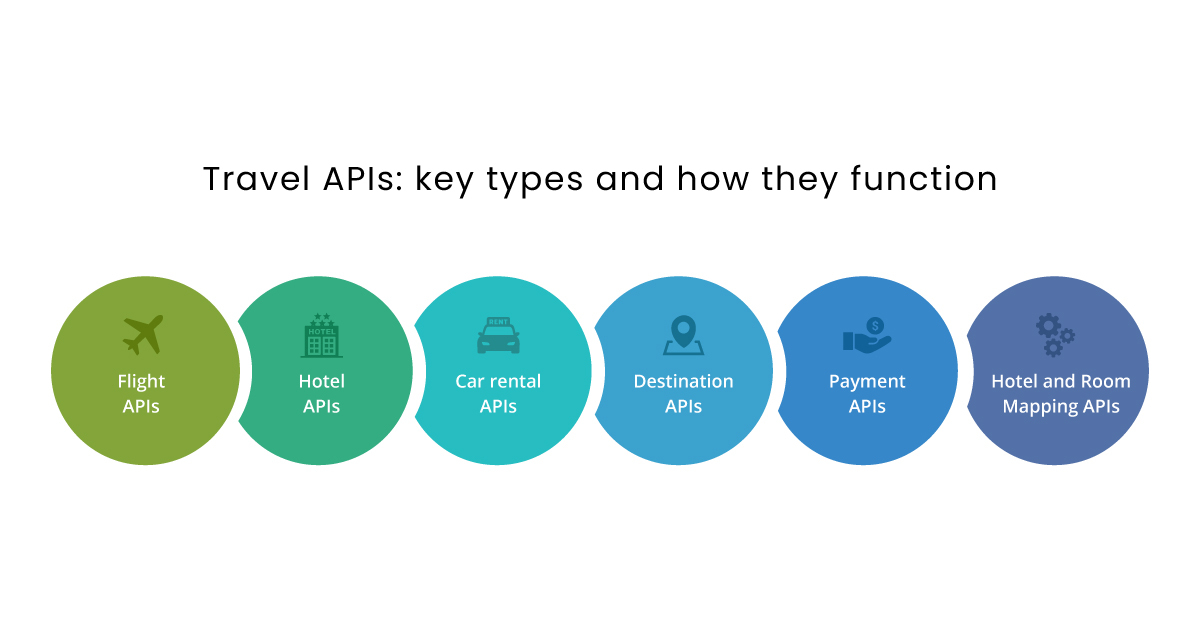
As we briefly touched upon earlier, Travel APIs are software intermediaries that allow travel websites, apps, and systems to access functionalities and data from multiple travel providers (such as airlines, hotels, car rental companies, etc.). These APIs enable travel companies to integrate various travel services into their platforms, streamline their operations, and offer a seamless experience to their customers.
The major travel APIs include:
- Flight APIs
The flight APIs provide access to flight information, such as schedules, prices, seat availability, and booking. Travel companies can use these APIs to build their own flight booking systems or display flight information on their websites.
- Hotel APIs
Hotel APIs provide access to hotel information, such as room availability, rates, and booking. Travel companies can use these APIs to build their own hotel booking systems or display hotel information on their websites.
- Car rental APIs
These APIs provide access to car rental information, such as availability, rates, and booking. Travel companies can use these APIs to build their own car rental systems or display car rental information on their websites.
- Destination APIs:
The Destinations APIs provide information about destinations, such as weather, local attractions, and events. Travel companies can use these APIs to build their own destination guides or provide destination information on their websites.
- Payment APIs
These APIs provide access to payment systems, allowing travel companies to process payments for travel bookings made on their platforms.
- Hotel and Room Mapping APIs
These APIs remove duplicate and inconsistent hotel listings from travel portals and standardize hotel and room content for travel businesses to ensure their customers get unique and detailed hotel and room information.
These APIs work by connecting travel companies to the systems of travel providers or wholesalers and allowing them to access and retrieve data. However, in this transmission of data between travel companies and wholesalers, a lot of inconsistencies also emerge, which lead to dissemination of duplicate and incorrect data, that’s when mapping APIs like Vervotech help in big way in keeping check on these regular inconsistencies in travel data.
To sum up, when a customer makes a travel request on a travel company’s website or app, these APIs are used to retrieve the information and make the booking with the relevant travel provider. The APIs then communicate the booking details back to the travel company’s platform, completing the transaction.
Recommended : Travel APIs: Flight, fare, rental, and public transport and the top vendors
Travel APIs are a crucial component for travel businesses in the digital age. These APIs act as intermediaries between travel businesses and travel providers, allowing the former to access and retrieve information about flights, hotels, car rentals, destinations, payments, and more. By integrating travel APIs into their platforms, travel businesses can provide a seamless, one-stop-shop experience to their customers, streamlining their operations and increasing customer satisfaction. From flight APIs to hotel and room mapping APIs, travel APIs are the key to providing a comprehensive travel solution to customers, making travel easier and more accessible.
About Vervotech:
Vervotech is a leading Hotel Mapping and Room Mapping API that leverages the power of AI and ML to quickly and accurately identify each property listing through the verification of multiple parameters. With One of the industry’s best coverage of 98% and an accuracy of 99.999%, Vervotech is quickly becoming the mapping software of choice for all leading global companies operating in the travel and hospitality industry. To learn more about Vervotech and the ways it can enhance your business in the long run contact us: [email protected]
Previous Post What is Hotel Mapping And Room Mapping? (Explained)
Next post vacation rental software: five key features to consider , related posts.

Boost Your OTA’s Profitability: The ROI of Investing in Hotel Mapping
Setting legacy code objectives for OTAs
General Data Protection Regulation (GDPR) for OTAs
Comments are closed.

3rd Floor, Amar Tech Centre, Viman Nagar, Pune, MH – 411014
For Sales Enquiry
- For US/Canada: 1 (833) 451-5836
- For Other Countries: +91 9923592502
- [email protected]

- Hotel Mapping
- Room Mapping
- Hotel Curated Content
- Wall of Love
- Press & Media
- Tech Partner
- Supplier Partner
- Walkthrough Videos
- Documentation
- Case Studies
- Infographics
Copyright © 2024 Vervotech Solutions Pvt. Ltd.

- Free Sample Data
- Brand Mapping
- Extranet Mapping
- Sync History
- Leadership Team
- Growth Story
- How We Innovate
- Values & Life at Vervotech
- Help Center
- Client Portal
- Provider Portal
- Contact Sales

Pratiksha Ghule
Customer Success - Executive
Working here has been a beautiful journey, filled with opportunities for growth, learning, and making meaningful connections.
At Vervotech, I’ve found more than just a workplace – I’ve found a second family. The people here are not only talented professionals but also incredibly kind-hearted individuals who are always willing to lend a helping hand and share their expertise. Together, we’ve tackled challenges, celebrated successes, and created memories I’ll cherish forever.
As I look back on my time at Vervotech, I’m filled with gratitude for the experiences I’ve had and the lessons I’ve learned. I’m proud to be part of a company that values innovation, collaboration, and diversity, and I’m excited to see what the future holds for us.

Vaibhav Shetty
Director – Customer Success
From having deep conversations with customers to understanding the technical intricacies of our products, every step has been a stepping stone.
Fast forward to today, I’m the Director of Customer Success at Vervotech. It’s a testament to the support and opportunities Vervotech offers for personal and professional development. I owe a debt of gratitude to my mentors and leaders, Sanjay Ghare and Dharmendra Ladi, whose wisdom and guidance have guided me through this incredible journey.
My journey at Vervotech goes beyond professional achievements, it’s not just about work here. I’ve made some lifelong friends and learned life lessons that go way beyond the office.
Vervotech Affiliate Partner Application Form
Which Vervotech product(s) do you want to promote? Please select all that apply. Hotel Mapping Room Mapping Hotel Curated Content
What will you need to be successful partner? (for example: image assets, product training, brand guidelines, etc.)
I accept the
terms & conditions
REFERRAL PARTNER AGREEMENT
THIS REFERRAL FORM EXECUTED BY REFERRAL PARTNER WITH COMPANY AND BETWEEN VERVOTECH SOLUTIONS PRIVATE LIMITED, HAVING ITS REGISTERED OFFICE AT FIRST FLOOR, FLAT NO. 101, E BUILDING, RICH WOODS, PLOT NO. 150, SECTOR 11, PCNTDA, CHIKHALI, PIMPRI CHINCHWAD, PUNE, MAHARASHTRA, 411019, IN, (“THE COMPANY”) AND YOU AS AN INDIVIDUAL REFERRAL PARTNER OR ANY SOLE PROPREITOR, PARTNERSHIP, LIMITED LIABILITY PARTNERSHIP, PRIVATE LIMITED COMPANY OR PUBLIC LIMITED COMPANY OR ANY OTHER BUSINESS ENTITY EXECUTING THE REFERRAL FORM (“THE REFERRAL PARTNER”) IS GOVERNED UNDER THE TERMS OF THIS REFERRAL PARTNER AGREEMENT (“AGREEMENT”). PLEASE READ THIS AGREEMENT CAREFULLY. BY CLICKING “ACCEPTED AND AGREED TO” REFERRAL PARTNER AGREES TO THE AGREEMENT APPLICABLE TO THE REFERRAL FORM.
REFERRAL PARTNER ACKNOWLEDGES THAT IT HAS READ THIS AGREEMENT, UNDERSTANDS IT, AND AGREES TO BE BOUND BY ITS TERMS, AND IF THE REFERRAL PARTNER IS A PERSON WHO IS SIGNING ON ITS BEHALF HAS BEEN AUTHORIZED TO DO SO AND THE COMPANY DOES NOT HAVE ANY LIABILITY TOWARDS VERIFYING THE AUTHORITY OF THE PERSON WHO HAS SIGNED THE AGREEMENT ON BEHALF OF THE REFERRAL PARTNER.
APPOINTMENT REFERRALS
Appointment. Company hereby appoints Referral Partner, and Referral Partner hereby accepts such appointment, as Company’s non-exclusive referral partner for the marketing and promotion of Services and the referral of leads for the sale of Services, as further set forth in this Agreement.
Scope of Authority Referral Partner's sole authority shall be to (a) market and promote Services as set forth in this Agreement, and (b) provide sales leads to Company for Company to contact in its sole discretion. The Parties agree that Company will directly enter into agreements with customers for the provision of Services to such customers.
DUTIES AND RESPONSIBILITIES OF THE REFERRAL PARTNER
Prior to undertaking any solicitation efforts of a prospective customer or client ("Prospect”) relating to the services or products or offerings of the Company as set out at https://vervotech.com/vervotech-affiliate-program ("Services”), Referral Partner shall submit a referral form, in a format shared by the Company ("Referral Form”), for written approval of the Company. The Referral Partner agrees to provide the necessary information, data and materials as may be requested by Company in respect of the Prospect. Referral Partner shall fill out a Referral Form and shall provide Company with the names of the Prospect to which Referral Partner intends to refer to the Services). If the Prospect is a large business entity, Referral Partner shall specify the name of division of such large entity in the customer list.
If a Prospect is approved by Company as a potential customer, Company will confirm such acceptance or rejection of such Prospect in writing via email to Referral Partner (“Referral Date”). Notwithstanding anything to the contrary, the Company will be entitled to accept or reject a Prospect at its own discretion, without providing any justifications or reasons in relation to the same. For the avoidance of doubt, Company reserves the right to decline to enter into a transaction with any prospect for lack of creditworthiness or for any other reason. Prospect which are not approved by Company are considered out of scope of Referral Fee. In the event Company does not notify Referral Partner of acceptance of the Prospect, it shall be deemed to be rejected.
In case Company notifies Referral Partner of its approval of a Prospect, the Referral Partner will provide assistance to the Company in establishing contact between the Prospect and the appropriate contact at Company, without any additional costs.
If the foregoing activities result in the Prospect entering into and executing a formal customer agreement with Company (hereinafter, a “Qualifying Transaction”), Referral Partner shall be entitled to a Referral Fee subject to receipt of amount invoiced to the customer for sale of Services through Qualifying Transaction (hereinafter, a “Qualified Sale”) and subject to the other conditions set forth under this Agreement; provided, however, that such Qualifying Transaction is consummated no later than six (6) months following the Referral Date.
A Prospect may not qualify as such, if, as on the Referral Date: (a) it is an existing customer of Company; (b) it has previously been contacted by Company, Company’ s affiliates or any other agent, reseller, vendor who markets Company’ s products and services; (c) it has previously been introduced or referred to Company as a potential prospect by a third party or (d) it is parent, subsidiary or affiliate of Company.
RESPONSIBILITIES OF THE REFERRAL PARTNER
Limited Authority Referral Partner will make no representations, warranties or guarantees on behalf of Company. Referral Partner has no authority to distribute or resell Services, or to make any commitments, agreements, or to incur any liabilities whatsoever on behalf of Company. Company will not be liable for any acts, omissions to act, contracts, commitments, promises or representations made by Referral Partner hereto. Referral Partner's activities under this Agreement shall be at its own cost and risk. Referral Partner shall not, without prior approval from Company, submit proposals, accept orders, negotiate and conclude contracts, and/or alter, vary or modify in any manner any of the terms and conditions of Company' s offer/ proposal / contract.
Assistance. Referral Partner shall make best efforts in performance of its responsibilities under the Agreement and provide reasonable support to Company.
Quarterly Meetings. Referral Partner agrees to meet, either in person or via teleconference, no less frequently than once every calendar quarter to discuss the status of the relationship contemplated herein and emerging opportunities and as directed by Company from time to time.
Training. Company shall have no obligations to provide the Referral Partner any training regarding the Services. Upon request of Referral Partner and in case the Referral Partner is an organization, Company shall make good faith efforts to provide sales training focused on the marketing and promotion of Services to Referral Partner employees, at REFERRAL PARTNER’s own cost.
Subcontracting. Referral Partner shall not subcontract any of its obligations under this Agreement.
Competing Products and Business Practices. During the term of this Agreement, Referral Partner shall promptly inform Company of Referral Partner promotion, marketing, or distribution of any product or service offering similar functionality to Services. Referral Partner (a) shall conduct its business under this Agreement in a manner that reflects favorably upon Company, Services, and Company's goodwill and reputation, (b) shall not engage in illegal, deceptive, misleading, or unethical trade practices, and (c) shall not, and shall not permit any of its subsidiaries or affiliates, or any of its or their respective directors, officers, managers, employees, independent contractors, representatives, or agents to, promise, authorize, or make any payment, or otherwise contribute any item of value, directly or indirectly, to any third party and in each case, in violation of the applicable anti-bribery or anti-corruption law.
Data Protection and Privacy. In the performance of the services set forth herein Referral Partner may receive or have access to personal data of the Company and its personnel. Referral Partner agrees to comply with the terms set forth in this Agreement, in its collection, receipt, transmission, storage, disposal, use and disclosure of such personal data. Referral Partner agrees to ensure compliance with applicable laws, rules and regulations, including but not limited to laws, rules and regulations related to personal data protection and data privacy. To the extent the Referral Partner will share any personal data with the Company, the Referral Partner shall be responsible for obtaining informed consent from such individuals for the processing of their personal data. The Referral Partner agrees to take all necessary steps to ensure compliance, including but not limited to executing appropriate contractual agreements as may be necessary as per applicable laws.
REPRESENTATIONS AND WARRANTIES
Representations and Warranties. Referral Partner represents and warrants that (a) it has the full corporate right, power and authority to enter into this Agreement and to perform its obligations hereunder, (b) the execution of this Agreement and the performance of its obligations hereunder does not and will not conflict with or result in a breach (including with the passage of time) of any other agreement to which it is a party, and (c) this Agreement has been duly executed and delivered by such Party and constitutes the valid and binding agreement of such Party, enforceable against such Party in accordance with its terms. Referral Partner further represents and warrants that it shall comply with all applicable data privacy laws while performing its obligations under the Agreement, and that it has all rights necessary to provide the Referral Form to Company for Company’s use pursuant to this Agreement. Referral Partner specifically represents and warrants that it has procured from all data subjects whose personal information it is disclosing to Company an explicit consent to disclose their personal information to Company for use in contacting them for marketing and/or other business purposes.
GENERAL DISCLAIMERS- EACH OF COMPANY AND REFERRAL PARTNER ACKNOWLEDGES AND AGREES THAT, IN ENTERING INTO THIS AGREEMENT, EXCEPT AS EXPRESSLY SET FORTH HEREIN, IT HAS NOT RELIED UPON ANY WARRANTIES, EXPRESS OR IMPLIED, AND THAT NEITHER PARTY HAS MADE ANY REPRESENTATIONS, ASSURANCES, OR PROMISES THAT COMPANY WILL RECEIVE ANY NEW REFERRED CUSTOMERS OR NEW BUSINESS OR THAT REFERRAL PARTNER WILL RECEIVE ANY REFERRAL FEES AS A RESULT OF THIS AGREEMENT. COMPANY DISCLAIMS ALL REPRESENTATIONS AND WARRANTIES REGARDING THE SERVICES, WHICH ARE PROVIDED AS-IS, WHETHER EXPRESS, IMPLIED, OR STATUTORY, ORAL OR IN WRITING, ARISING UNDER ANY LAWS, INCLUDING WITH RESPECT TO ERROR-FREE OPERATION, MERCHANTABILITY, FITNESS FOR A PARTICULAR PURPOSE, OR NON-INFRINGEMENT.
In consideration of the Services provided by the Referral Partner in accordance with the Agreement, Company will pay to the Referral Partner as per the Referral Fee specified below, which shall be Company’ s sole payment obligation.
Referral Fee: For any invoices issued pursuant to Qualified Sales received by Company from customer during the referral period, Company shall pay Referral Partner a Referral Fee as per the % (mentioned on the referral Page) of the amount actually collected by Company from customer as a one-time Referral Fee.
Company shall make payment of undisputed invoice raised by Referral Partner within Sixty (60) days of the date of Company' invoice to customer for the Qualified Sales.
Company shall not pay or reimburse Referral Partner for any expenses related to this Agreement, unless expressly agreed to by Company in writing, before such expenses were incurred.
Limitation on Referral Fee:
Company will not pay more than one (1) Referral Fee in connection with any given Qualified Sales.
Referral Partner will receive the Referral Fee only as one-time fee.
Referral Partner will not be entitled to receive any Referral Fees for any subsequent services which are beyond the first transaction.
A renewal of a Qualified Sale shall not be considered a new Qualifying Transaction and shall not entitle Referral Partner to any Referral Fee.
Referral Fee shall be paid only when the actual invoicing amount have been collected from Qualified Sales. Referral Partner shall not be entitled to receive payment of Referral Fees for Qualifying Transactions remaining unpaid.
LICENSES AND OWNERSHIP
Company Marks. Subject to the terms and conditions set forth in this Agreement and solely for the purposes hereof, Company grants to Referral Partner a non-transferable, non-exclusive license, without right of sublicense, to use the Company trademarks, service marks, and logos as approved by Company (the “Company Marks”) to perform its obligations set forth in this Agreement. The use of all Company Marks, including placement and sizing, shall be subject to Company’s then-current trademark use guidelines, if any, provided by the Company. If the Company Marks become, or in Company’s opinion are likely to become, the subject of an infringement claim, Company may at its option modify or replace the Company Marks and require Referral Partner to cease use of the allegedly infringing Company Marks. Referral Partner shall promptly provide Company with samples of all materials that use the Company Marks for Company’s quality control purposes. If, in Company’s discretion, the Referral Partner’s use of the Company Marks does not meet Company’s then-current trademark usage policy, Company may, at its option, require Referral Partner to revise such material and re-submit it under this Section prior to display, or release of further materials bearing or containing such Company Marks. Except for the right to use the Company Marks set forth above, nothing contained in this Agreement shall be construed to grant to Referral Partner any right, title or interest in or to the Company Marks, and all right, title, and interest in and to the Company Marks shall be retained by Company. Referral Partner acknowledges that Company asserts its exclusive ownership of the Company Marks and the renown of the Company Marks worldwide. Referral Partner shall not take any action inconsistent with such ownership and further agrees to take all actions that Company reasonably requests to establish and preserve its exclusive rights in and to the Company Marks. Referral Partner shall not adopt, use, or attempt to register any trademarks or trade names that are confusingly similar to the Company Marks or in such a way as to create combination marks with the Company Marks.
Company Materials. Subject to the terms and conditions set forth in this Agreement and solely for the purposes hereof, Company grants to Referral Partner a non-transferable, non-exclusive license, without right of sublicense, to distribute the Company Materials exactly as provided to Referral Partner by Company to perform Referral Partner’s obligations under this Agreement.
Ownership. As between Referral Partner and Company, Company retains all right, title, and interest to (a) the Company Marks, (b) the Services, any of its products, material or pre-existing intellectual property rights (c) the high-level description of the Company Products and the Company Materials, and (d) all Intellectual Property Rights related to any of the foregoing. There are no implied licenses under this Agreement.
No Intellectual Property Rights. Parties agree that no intellectual property rights are conceived or developed under this Agreement. If any intellectual property rights are conceived or developed, the intellectual property rights will vest with Company, unless otherwise agreed by the parties.
CONFIDENTIALITY
In connection with this Agreement, “Confidential Information” means all data and information of a confidential nature of Company disclosed by Company to the Referral Partner under this Agreement, as well as information that Referral Partner knows or reasonably should know that the Company regards as confidential, including business practices, software, technical information, future product/services plans, programming/design techniques or plans, know-how, trade secrets, prospects, customers, end users suppliers, development plans or projects, and services. Confidential Information may be communicated orally, in writing, or in any other recorded or tangible form.
Confidentiality. Referral Partner shall maintain in confidence all Confidential Information disclosed to it by the Company. Referral Partner shall not use for any purpose outside the scope of this Agreement, or disclose to any third party such Confidential Information except as expressly authorized by this Agreement. To the extent that disclosure is authorized by this Agreement, the Referral Partner shall obtain prior agreement from its employees, contractors, agents, and consultants to whom disclosure is to be made to hold in confidence and not make use of such information for any purpose other than those permitted by this Agreement. Referral Partner shall use at least the same standard of care as it uses to protect its own most confidential information (and in no event less than reasonable care) to ensure that such employees, contractors, agents, and consultants do not disclose or make any unauthorized use of such Confidential Information. Referral Partner shall promptly notify the other upon discovery of any unauthorized use or disclosure of the Confidential Information. Notwithstanding any other provision in this Agreement to the contrary, the obligations set forth in this section 7 shall survive any termination or expiration of this Agreement for perpetuity.
Exceptions. The obligations of confidentiality contained in this section 7 shall not apply to the extent that it can be established by the Referral Partner by competent proof that such Confidential Information:
was already known to the Referral Partner, other than under an obligation of confidentiality, at the time of disclosure by the Company;
was generally available to the public or was otherwise part of the public domain at the time of its disclosure to the Referral Partner;
became generally available to the public or otherwise became part of the public domain after its disclosure, other than through any act or omission of the Referral Partner in breach of this Agreement; or
was disclosed to the receiving Party, other than under an obligation of confidentiality, by a third party who had no obligation not to disclose such information to others.
Authorized Disclosure. Notwithstanding any provision to the contrary, the Referral Partner may disclose Confidential Information (a) to the extent required by law or any governmental authority, or (b) on a “need to know” basis under an obligation of confidentiality to its legal counsel or accountants, provided, that such Referral Partner shall to the extent practicable (and except to the extent it would jeopardize the filing or prosecution of letters patent) use commercially reasonable efforts to assist the Company in securing confidential treatment of such information required to be disclosed. Prior to disclosing any Confidential Information under this section 7 Referral Partner shall take reasonable steps to give the Company sufficient notice of the disclosure request for the Company to contest the disclosure request.
Referral Partner shall indemnify, defend, and hold Company harmless from and against any and all liabilities, losses, damages, costs, fees, and expenses (including reasonable attorneys’ fees) resulting from or arising out of any Claims based on allegations that (a) Referral Partner breached any obligations including with limitation Confidential Information, representation or warranty contained herein, or has breached any applicable laws, rules and regulations, or (b) Referral Partner made a representation or warranty regarding Company or the Services that is inconsistent with the written high-level description of Services provided to Referral Partner by Company, or is otherwise unauthorized by Company.
Indemnification Procedure. An indemnifying party hereunder shall be liable for any costs and damages to third parties incurred by the other party which are attributable to any such Claims, provided that such other party (i) notifies the indemnifying party promptly in writing of the claim, (ii) gives the indemnifying party the sole authority to defend, compromise or settle the claim, with prior approval of the Company and (iii) provides all available information, assistance, and authority at the indemnifying party’s reasonable request and at the indemnifying party’s reasonable expense to enable the indemnifying party to defend, compromise, or settle such claim. Any indemnifying party hereunder shall diligently pursue any defense required to be rendered hereunder, shall keep the indemnified party informed of all significant developments in any action defended by the indemnified party, and shall not enter into any settlement affecting the indemnified party’s interests without the prior consent of the indemnified party.
LIMITATION OF LIABILITY
COMPANY SHALL NOT BE LIABLE TO REFERRAL PARTNER OR ANY THIRD PARTY FOR ANY INDIRECT DAMAGES INCLUDING TOWARDS COSTS OF PROCUREMENT OF SUBSTITUTE GOODS, LOST PROFITS OR ANY OTHER SPECIAL, CONSEQUENTIAL, INCIDENTAL OR INDIRECT DAMAGES, HOWEVER CAUSED, AND WHETHER BASED ON CONTRACT, TORT (INCLUDING NEGLIGENCE), PRODUCTS LIABILITY OR ANY OTHER THEORY OF LIABILITY, REGARDLESS OF WHETHER COMPANY HAS BEEN ADVISED OF THE POSSIBILITY OF SUCH DAMAGES. NOTWITHSTANDING ANYTHING TO THE CONTRARY, THE MAXIMUM AGGREGATE LIABILITY OF COMPANY FOR DIRECT DAMAGES FOR ANY REASON SHALL BE LIMITED TO AMOUNTS PAID BY COMPANY IN RESPECT OF THE QUALIFYING SALE . THESE LIMITATIONS WILL APPLY NOTWITHSTANDING THE FAILURE OF THE ESSENTIAL PURPOSE OF ANY REMEDY.
NON-SOLICITATION OF PERSONNEL
The Referral Partner shall not engage or hire as an employee or engage as independent contractor, Company’ s employees or independent contractors during the term of this Agreement and for a period of one (1) year following expiration or termination of this Agreement except as may be mutually agreed in writing.
TERM AND TERMINATION:
Term. The term of this Agreement shall be one (1) year from the Effective Date unless terminated earlier in accordance with the provisions of this Section. This Agreement shall renew automatically for additional one-year terms unless one Party provides the other written notice no later than thirty (30) days prior to the expiration of the then-current term of the Agreement of its intention to allow the Agreement to expire at the end of such term.
Termination for Breach. Either Party may terminate this Agreement for cause resulting from the material breach of this Agreement by the other Party by providing the breaching party written notice of such material breach and the intention to terminate for cause. The Party receiving such notice shall have thirty (30) days to cure such material breach. If at the end of such thirty (30) day period, the breach has not been cured to the reasonable satisfaction of the Party seeking to terminate the Agreement, the Agreement shall terminate.
Termination for Convenience. Either Party may terminate this Agreement for convenience upon ninety (90) days’ written notice.
Effect of Termination; Duties of the Parties Upon Termination. Upon any termination or expiration of this Agreement, Referral Partner shall (a) refrain thereafter from representing itself as a promoter or marketer of Company Products, or as a referral partner of Company, (b) immediately cease all use of any Company Marks, and (c) return to Company the Company materials and Confidential Information and all tangible items in Referral Partner’s possession or under its control containing Confidential Information of Company. Upon any termination or expiration of this Agreement, Company shall return to Referral Partner all tangible items in Company’s possession or under its control containing Referral Partner’s Confidential Information. Upon any termination or expiration of this Agreement, all licenses granted under this Agreement shall terminate.
Survival. Any clauses which by their very nature survive termination of the Agreement, will survive.
MISCELLANEOUS:
Construction. The Parties have participated jointly in the negotiation and drafting of this Agreement. In the event an ambiguity or question of intent or interpretation arises, this Agreement shall be construed as if drafted jointly by the Parties and no presumption or burden of proof shall arise favoring or disfavoring any Party by virtue of the authorship of any of the provisions of this Agreement. As used in this Agreement, the singular shall include the plural and vice versa, and the terms “include” and “including” shall be deemed to be immediately followed by the phrase “without limitation.” The captions and headings in this Agreement are inserted for convenience and reference only and in no way define or limit the scope or content of this Agreement and shall not affect the interpretation of its provisions.
Governing Law and Dispute Resolution: This Agreement will be governed by and construed in accordance with the laws of the India, without reference to its conflict-of-laws principles. The Parties shall resolve any difference or dispute arises out of this Agreement by way of negotiations. If such negotiation process fails, then all disputes arising from or related to this Agreement shall be resolved before exclusive jurisdiction of courts in Pune, India.
NOTICES: All notices including hereunder shall be given in writing by hand delivery, courier service or email at the addresses set forth below:
If to Company
If to REFERRAL PARTNER
Attention: Sanjay Ghare
Email: [email protected]
Address: 3rd Floor, Amar Tech Centre, Sakore Nagar, Viman Nagar, Pune, Maharashtra 411014
Non-Waiver: A party's failure or delay in enforcing any provision of the Agreement will not be deemed a waiver of that party's rights with respect to that provision or any other provision of the Agreement. A party's waiver of any of its rights under the Agreement is not a waiver of any of its other rights with respect to a prior, contemporaneous or future occurrence, whether similar in nature or not.
Captions: The captions in the Agreement are not part of the Agreement, but are for the convenience of the parties. References to Sections are to sections of this Agreement.
Counterparts. Any documents signed in connection with the Agreement may be signed in multiple counterparts, which taken together will constitute one original.
Severability: In the event any term of the Agreement is held unenforceable by a court having jurisdiction, the remaining portion of the Agreement will remain in full force and effect, provided that the Agreement without the unenforceable provision(s) is consistent with the material economic incentives of the parties leading to the Agreement.
Relationship between the Parties. The relationship of Referral Partner and Company is that of independent contractors. Regardless of the use of the word "partner" in the title of this Agreement, neither Party is, nor shall be deemed to be, a partner, joint venturer, agent, or legal representative of the other Party for any purpose. Neither Party shall be entitled to enter into any contracts in the name of or on behalf of the other Party, and neither Party shall be entitled to pledge the credit of the other Party in any way or hold itself out as having authority to do so. No Party shall incur any debts or make any commitments for the other, except to the extent, if at all, explicitly provided herein.
Assignment. Referral Partner shall not assign or transfer this Agreement, in whole or in part, whether by operation of law or otherwise, or delegate any of its obligations hereunder, without the express written consent of Company. Subject to the foregoing, this Agreement shall be binding upon the successors and permitted assigns of the Parties. Any assignment in violation of the foregoing shall constitute a material breach of this Agreement and shall be null and void.
Force Majeure. Neither Party shall be liable for any failure or delay in fulfilling the terms of this Agreement due to fire, strike, war, civil unrest, terrorist action, government regulations, acts of nature or other causes which are unavoidable and beyond the reasonable control of the Party claiming force majeure.
Entire Agreement. The Agreement constitutes and contains the complete, final and exclusive understanding and agreement of the Parties and cancels and supersedes any and all prior negotiations, correspondence, understandings, and agreements, whether oral or written, between the Parties respecting the subject matter thereof. Parties agree that, their engagement with each other is on non-exclusive basis and either Party is free to appoint any third party for performance of their respective obligations.
Electronic Record. This Agreement is an electronic record in the form of an electronic contract formed under Information Technology Act, 2000 and rules made thereunder and the amended provisions pertaining to electronic documents / records in various statutes as amended by the Information Technology Act, 2000. This Agreement does not require any physical, electronic or digital signature. This Agreement constitutes a legally binding document between the Subscriber and the Company.
hfghfghfshdfhd
Referer's Information:
Referral information:, referral details:.

Pravin Mahadik
Chief Financial Officer
Pravin Bandu Mahadik is an ICMAI fellow and accomplished Cost and Management Accountant (CMA) with over a decade of experience in accounts and finance.
As a leader, Pravin has worked across various financial domains, including commercial operations, accounts and finance, auditing, taxation, MIS, transfer pricing, and export management.
He consistently introduces and implements systems to fortify financial control and improve Vervotech’s net organizational efficiency.
Marvel Puri
Chief Revenue Officer
As chief revenue officer (CRO), Marvel is responsible for every process at Vervotech that generates revenue. He has been instrumental in connecting different revenue-related functions, from sales, customer success, pricing, and revenue operations. His focus-driven approach to improving sales performance, and creating great product and pricing strategy, and delivering customer satisfaction has helped Vervotech to acquire 100 clients within a short stint of 2 years.
With the experience of over 15+ years in sales and business development at SaaS-based organizations, Marvel has flourished throughout his career by creating and leading experienced and diverse teams. To Marvel, growth has not only been to hit quotas but is broad and holistic: open new paths to revenue and build the processes to get there.

Ganesh Pawade
Ganesh is a Problem Solver and a Thought Leader. Throughout his 13 yrs professional journey, he helped businesses to identify their platform areas, define solutions and architecture, and make a more technically-informed decision on their current and future business as well as the technology roadmap.
His passion for good code often results in him being engaged in animated discussions with his team of architects and engineers, pushing them to think beyond what is possible. His specialties include Solution Architecture, Full stack specialist, AWS, Azure and Google cloud.

Dharmendra Ladi
Dharmendra Ladi has been instrumental in positioning Vervotech as the “World’s Best Mapping Provider” and is focused on transforming how the industry presents accommodation data to its customers. With his 14+ years of experience in travel and innovative technologies, he is the principal architect behind designing Vervotech’s AI-driven products that are today helping its clients worldwide do business seamlessly.
He leads new product development. Under his leadership, Vervotech has is credited with going from 0 to 100 customers within 2 years of business establishment. Dharmendra is also an inspiring thought leader, and regularly speaks at large scale events, webinars and has been interviewed by multiple media houses.

Sanjay Ghare
CEO & MD
Sanjay brings over 16+ years of entrepreneurial, general management, and senior executive experience with proven expertise in business development, corporate strategy, and product & program management. Sanjay, being an Industry veteran, and an influencer, leads and drives Vervotech’s vision of “Organizing World’s Accommodation Data.” Before he founded Vervotech, he was a VP of Tavisca Solutions, where he took the started SaaS division and grown with customers in more than 15 countries.
With his business acumen, Sanjay is on the trajectory of revolutionizing the accommodation data segment. He’s also a member of the Forbes Technology Council and often puts actionable growth strategies into perspective in his Forbes column.

Anurag Mittal
Chief Marketing Officer
Anurag Mittal is a seasoned technology executive who has led multiple marketing teams at SaaS-based organizations. At Vervotech, Anurag is responsible for marketing and strategy formulation and setting up a growth-oriented marketing & prospecting team. Anurag comes with an experience working with Organizations like Deloitte and ACCELQ, where he led the marketing initiatives for their SaaS product lines and has worn many hats including devising marketing strategies for business growth, managing GTM with alliances and partners, conceptualizing and orchestrating marketing campaigns, end-to-end event management, and demand generation activities to deliver a qualified sales pipeline.
He has been strategic face for the launch of Vervotech’s website and digital presence and have led several winning campaigns that has led to successful brand development and customer acquisition.
Start Free Trial
Get free trial.
Business Email *
Company Name
Schedule a Demo
Error: Contact form not found.
Easy, right?
Within 48 hours, we will email you the entire list of mapped hotels with Vervotech ID
Company Name *
Name of Suppliers (separated by comma) *
Rohit Shukla
Chief Product Officer
As Vervotech’s Chief Product Officer, Rohit is responsible for the product strategy and teams working to advance Vevotech’s position as a leading accommodation data company for OTAs, bed banks, DMCs, and Tour operators.
Rohit has been in the technology space for the last 15+ years, working with companies at different stages of growth within Travel, E-commerce, and FinTech Industries. In his previous roles, he drove product strategies for start-ups and SMEs and was instrumental in building platforms and product lines that generated $900 million in revenues and half a million paid customers. The products included flights, hotels, car rentals, activities & vacation packages.
Archana Garg
Financial Advisor
Archana has more than 15 years of experience in finance and operations management. Archana is proven leader in building and scaling companies as a result of her focus on financial strategy and operational excellence. She is motivated by understanding the customers she serves, and providing value at all levels of a business while building strong relationships with her colleagues.
She is a Chartered Accountant and is responsible for driving the Vervotech’s overall financial strategy, including the growth plans. Her experience navigating high growth companies, developing new business strategies and overall operational mindset delivers meaningful results for growth stage of Vervotech.
Business Email * Company Name *
Get your free EBOOK!
Job openings.
I'd like to Ask a product question Schedule a Demo Talk to sales Invite to RFI/RFP Partner with Vervotech Other
Your information will be used to send you this and other relevant offers by email. We will never sell your information to any third parties. You can, of course, unsubscribe at any time. View our full Privacy Statement .
Advertisement
Photo Appears to Capture Path of Bullet Used in Assassination Attempt
Michael Harrigan, a retired F.B.I. special agent, said the image captured by Doug Mills, a New York Times photographer, seems to show a bullet streaking past former President Donald J. Trump.
- Share full article

By John Ismay
Reporting from Washington
- July 14, 2024
Follow the latest news on the Trump assassination attempt.
In documenting the Pennsylvania campaign rally on Saturday afternoon that turned into an attempt on a former president’s life, Doug Mills, a veteran New York Times photographer, appeared to capture the image of a bullet streaking past former President Donald J. Trump’s head.
That is the assessment of Michael Harrigan, a retired F.B.I. special agent who spent 22 years in the bureau.
“It absolutely could be showing the displacement of air due to a projectile,” Mr. Harrigan said in an interview on Saturday night after reviewing the high-resolution images that Mr. Mills filed from the rally. “The angle seems a bit low to have passed through his ear, but not impossible if the gunman fired multiple rounds.”
Simple ballistic math showed that capturing a bullet as Mr. Mills likely did in a photo was possible, Mr. Harrigan said.
Mr. Mills was using a Sony digital camera capable of capturing images at up to 30 frames per second. He took these photos with a shutter speed of 1/8,000th of a second — extremely fast by industry standards.
The other factor is the speed of the bullet from the firearm. On Saturday law enforcement authorities recovered an AR-15-type semiautomatic rifle at the scene from a deceased white man they believe was the gunman.
“If the gunman was firing an AR-15-style rifle, the .223-caliber or 5.56-millimeter bullets they use travel at roughly 3,200 feet per second when they leave the weapon’s muzzle,’’ Mr. Harrigan said. “And with a 1/8,000th of a second shutter speed, this would allow the bullet to travel approximately four-tenths of a foot while the shutter is open.”
“Most cameras used to capture images of bullets in flight are using extremely high speed specialty cameras not normally utilized for regular photography, so catching a bullet on a side trajectory as seen in that photo would be a one in a million shot and nearly impossible to catch even if one knew the bullet was coming,” he said.
In Mr. Harrigan’s last assignment, he led the bureau’s firearms training unit and currently works as a consultant in the firearms industry.
“Given the circumstances, if that’s not showing the bullet’s path through the air, I don’t know what else it would be,” he said.
John Ismay is a reporter covering the Pentagon for The Times. He served as an explosive ordnance disposal officer in the U.S. Navy. More about John Ismay
Our Coverage of the Trump Rally Shooting
The Investigation : F.B.I. officials said the 20-year-old gunman who tried to assassinate former President Donald Trump appears to have acted alone , but investigators remain unsure of his motives.
Secret Service Under Scrutiny : President Biden called for an “independent review” of security measures before and after the shooting, while directing the Secret Service to review all of its security measures for the Republican National Convention.
Tearing America Further Apart : The assassination attempt comes at a time when the United States is already polarized along ideological and cultural lines and is split, it often seems, into two realities.
Our Photographer’s Account : Doug Mills, a veteran photographer for The New York Times, was only feet away from Trump when the shooting started. He described what happened .
The Force of the Photos : In video footage of the shooting, everything was pandemonium. It was still images that made Trump an incarnation of defiance, our critic writes .
Expedia Rewards is now One Key™
Elektrostal, visit elektrostal, check elektrostal hotel availability, popular places to visit.
- Electrostal History and Art Museum
You can spend time exploring the galleries in Electrostal History and Art Museum in Elektrostal. Take in the museums while you're in the area.
- Cities near Elektrostal

- Places of interest
- Yuri Gagarin Cosmonaut Training Center
- Central Museum of the Air Forces at Monino
- Peter the Great Military Academy
- Bykovo Manor
- Balashikha Arena
- Balashikha Museum of History and Local Lore
- Pekhorka Park
- Ramenskii History and Art Museum
- Orekhovo Zuevsky City Exhibition Hall
- Malenky Puppet Theater
- Noginsk Museum and Exhibition Center
- Saturn Stadium
Members can access discounts and special features
Elektrostal, visit elektrostal, check elektrostal hotel availability, popular places to visit.
- Electrostal History and Art Museum
You can spend time exploring the galleries in Electrostal History and Art Museum in Elektrostal. Take in the museums while you're in the area.
- Cities near Elektrostal

- Places of interest
- Yuri Gagarin Cosmonaut Training Center
- Central Museum of the Air Forces at Monino
- Peter the Great Military Academy
- History of Russian Scarfs and Shawls Museum
- Bykovo Manor
- Balashikha Arena
- Fryazino Centre for Culture and Leisure
- Military Technical Museum
- Church of Our Lady of Kazan
- Drama Theatre BOOM
- Balashikha Museum of History and Local Lore
- Pekhorka Park
- Ramenskii History and Art Museum
- Orekhovo Zuevsky City Exhibition Hall
- Borisoglebsky Sports Palace
- Fairy Tale Children's Model Puppet Theater
- Malenky Puppet Theater
- Church of Vladimir
- Shirokov House
- Pavlovsky Posad Museum of Art and History
- Noginsk Museum and Exhibition Center
- Saturn Stadium
- Zheleznodorozhny Museum of Local Lore
- Stella Municipal Drama Theater
- Fifth House Gallery
- Likino Dulevo Museum of Local Lore
- Malakhovka Museum of History and Culture
- Art Gallery of The City District

IMAGES
VIDEO
COMMENTS
For Agent B (Travel Agent) you want to provide with a competitive markup of 5%. For Agent C (Friend Agent) you want to give the best rate possible and put a markup of 0%. Each time, when you will update any of the rates for the rooms or supplements, your agents will automatically receive the prices according to markups assigned by you.
Demystifying Mark-ups and Their Benefits for travel agencies A mark-up is the additional percentage you add to your base cost (often the supplier's rate) to generate profit. Think of it as your value proposition - the additional revenue you earn for the expertise and services you provide. Here's how strategic mark-ups empower your travel ...
A Look at How Travel Agents Make Money. The average travel agent earns between $47,000 and $55,000 annually. Most travel agents' income is made up of their salary, but they also earn from commissions, service fees, and markups. Generally, the more experienced and niche a travel agent is, the higher the commission and other fees they charge.
Markup is generally known as the amount a business adds to the cost of a product to make up the final selling price so they can make money. Margin is generally known as the profit generated after accounting for costs. Markup is shown as a percentage of costs while margin is shown as a percentage of revenue. These two terms usually get confused ...
Markups are pivotal for tailoring pricing strategies to maximize profitability and competitiveness in the travel industry. Here's a comprehensive guide to assist you in configuring markups effectively: Understanding Markups in PHPTRAVELS: Markups are essential tools for adjusting prices on the services offered through our software.
The retail markup. By Alan Fredericks. |. Nov 18, 1998. |. The extension of commission caps to international tickets underscores the need for travel agencies to adopt markups as a guiding ...
Mark-up Strategies for Travel Agencies. Mark-ups are best used to secure greater business and boost profit. Mark-up strategies play a major role in the travel business. Build a strong inventory or content from your suppliers, directly contracted hotels, activities etc. You can add a markup on these through a markup profile.
You must understand the markup other travel agencies and online travel agencies have to specify your markup and balance competition with profitability. Try setting bespoke markups for all your target suppliers. We've described how pricing rules work at online travel agencies. They can be as simple as setting a single markup figure for all ...
Changing from supplier commissions to a net-markup basis requires more than a change in the business model of a travel agency. It requires the agency to change the way it thinks about itself.
The markup mechanism is a method of either increasing or decreasing prices of your travel products. Markups can be set at a fixed value or as a percentage (or as a combination o... How to configure a markup? In this video, we will explain you how to configure a markup. In case of any questions, please reach out to us by clicking on 'Submit a ...
Group Booking Markups: Organizing group tours enables them to negotiate favorable rates with suppliers and earn markups on group bookings. Corporate Travel Agencies. After understanding the revenue streams in travel agencies, corporate travel agencies stand out as a significant source of income. These agencies specialize in managing business ...
1. Billing the actual cost - if an expense amounts to $100, the agency can ask their client to cover that cost. 2. Adding a markup - if an expense amounts to $100 and the agency markup is 5%, the client will end up paying $105. In a nutshell, adding a markup, in this case, has generated 5% extra revenue for the agency.
OK - let's assume they included transfers to/from hotels and lodge. They are about $100 each way. If you need to get to/from FedAir for your Madikwe flights (and I don't know about that) then it's ...
Travel APIs allow consolidating real-time data from numerous suppliers onto far fewer platforms, reducing search friction. ... Pricing Markups to set profit margin on rentals; XML/JSON output for smooth integration; Partners can become an authorized reseller by subscribing to the API. Common use cases include travel marketplaces, price ...
Travel Talks Platform - the platform with knowledge and tips for the travel industry https://www.traveltalksplatform.com The right way to markup net rates This information is for anyone works with suppliers that offer net rates. Typically, you will come across a net rate situation when working with Ground Operators or
An agency is not legally obligated to disclose markups or fees. Q: An article in Travel Weekly's May 16 edition, "Searching for air, flyer beware," covered false and misleading practices by ...
The old 40% markup is long gone, especially with all the financial issues the RV industry has faced along with gas prices, and the 2008-2010 collapse of housing and financial institutions. If you are simply buying on price, I would suggest not getting an RV and look at a boat, as those manufacturers and dealers are so much more up front about ...
The most common types of Travel Schema include a hotel's location, phone number, information about room amenities, star ratings and reviews, room information, pricing, and FAQ; but, as you'll shortly see, there are many others for you to use. Here's another example of a travel SERP listing featuring schema markup Google uses to display the ...
Things to Do Restaurants Flights Travel Stories Cruises Rental Cars More. Add a Place Airlines Travelers' Choice Help Center. Plan Your Trip to Elektrostal: Best of Elektrostal Tourism. By crimso76. 513. Elektrostal, Russia. Essential Elektrostal. Do. Places to see, ways to wander, and signature experiences.
Travel APIs: key types and how they function. As we briefly touched upon earlier, Travel APIs are software intermediaries that allow travel websites, apps, and systems to access functionalities and data from multiple travel providers (such as airlines, hotels, car rental companies, etc.). These APIs enable travel companies to integrate various ...
Things to Do in Elektrostal. 1. Electrostal History and Art Museum. 2. Statue of Lenin. 3. Park of Culture and Leisure. 4. Museum and Exhibition Center.
Michael Harrigan, a retired F.B.I. special agent, said the image captured by Doug Mills, a New York Times photographer, seems to show a bullet streaking past former President Donald J. Trump.
Travel Guide. Check-in. Check-out. Guests. Search. Explore map. Visit Elektrostal. Things to do. Check Elektrostal hotel availability. Check prices in Elektrostal for tonight, Jun 15 - Jun 16. Tonight. Jun 15 - Jun 16. Check prices in Elektrostal for tomorrow night, Jun 16 - Jun 17. Tomorrow night.
Travel guide resource for your visit to Elektrostal. Discover the best of Elektrostal so you can plan your trip right. Vacation Packages. Stays. Cars. Flights. Support. All travel. Vacation Packages Stays Cars Flights Cruises Support Things to do. My Account. Members can access discounts and special features.
As a comprehensive international banking solutions platform, Niyo is the perfect destination for all your travel needs. With Niyo, you can get a zero forex markup card online, maximize your savings, use as UPI payment app, apply for visa and insurance—all while earning rewards as Niyo Coins. Why Choose Niyo? Zero Forex Markup